#1964 american tour
Text
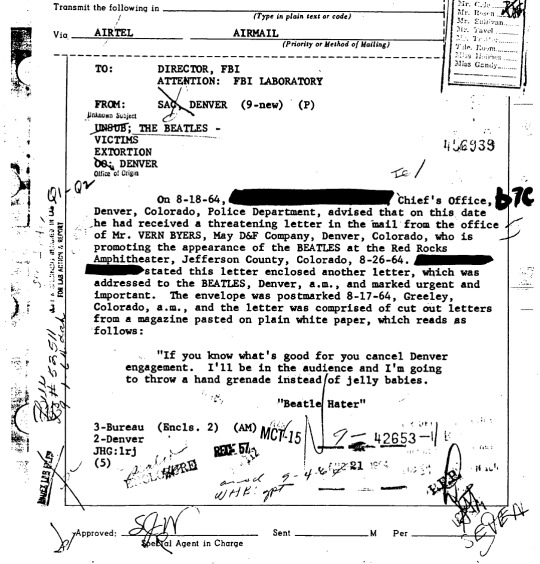


Excerpt from the Beatles’ FBI file regarding the death threat they received in August 1964 ahead of their show in Denver, CO.
[Transcript beneath the cut:]
TO: DIRECTOR, FBI
ATTENTION: FBI LABORATORY
FROM: SAC, DENVER (9-new) (P)
UNSUB [Unknown Subject]; THE BEATLES -
VICTIMS
EXTORTION
OO [Office of Origin]: DENVER
On 8-18-64, [redacted], Chief’s Office, Denver, Colorado, Police Department, advised that on this date he had received a threatening letter in the mail from the office of Mr. VERN BYERS, May D&F Company, Denver, Colorado, who is promoting the appearance of the BEATLES at the Red Rocks Amphitheater, Jefferson County, Colorado, 8-26-64. [Redacted] stated this letter enclosed another letter, which was addressed to the BEATLES, Denver, a.m., and marked urgent and important. The envelope was postmarked 8-17-64, Greeley, Colorado, a.m., and the letter was comprised of cut out letters from a magazine pasted on plain white paper, which reads as follows:
“If you know what’s good for you cancel Denver engagement. I’ll be in the audience and I’m going to throw a hand grenade instead of jelly babies.
“Beatle Hater”
#lord. no wonder george martin was so worried about their safety#1964#1964 american tour#the beatles#cw death threats#cw violence#FBI#probably on here somewhere already but w/e#eta: oops fixed transcript typo
165 notes
·
View notes
Text




John Lennon with Jayne Mansfield on August 25th, 1964, at Whiskey Au Go-Go in Los Angeles, California, during The Beatles' First American Tour🌟
When discussing her and John's conversation of the night, Jayne Mansfield said, "It was a very high level discussion. We discussed this year's Shakespeare Festival, you know. We then discussed poetry. And we talked about John's book and my record album, Tchaikovsky, Shakespeare and me.”🌟
Via @dailyjohnlennon on Instagram🌟
#60s icons#girlsofthesixties#the Beatles#john lennon#george harrison#ringo starr#jane mansfield#hollywood star#first American tour#whiskey a go go#Los Angeles#August 1964
21 notes
·
View notes
Text


Celebrating going to No. 1 in the U.S. charts with a pillow fight, January 1964. Photos by Harry Benson.
“One of The Beatles — George, I think — was on the phone to some fan who managed to get a call through to them, and John hit him with a pillow. I said, ‘Do you do this often?’ And they said, ‘All the time.’ But I waited and didn’t do anything about it at the time. I waited for the right moment and it came a few days later. After one of the Paris shows at the Olympia, [Brian] Epstein came in at 3 AM to tell them ‘I Want To Hold Your Hand’ was the number one song in America and they would be going there for the Ed Sullivan Show and their first American tour. When Epstein left the room I knew it was time. I said, ‘How about a pillow fight?’
They were caged up after each of the performances they gave at the Olympia, so there was a violent energy in them — this tremendous energy that had to be let out. They needed a way to let off steam. […] The pillow fight became quite rough. They all seemed to take pleasure in hitting Paul. Paul was acting a bit superior so they really enjoyed giving it to him and he definitely got the worst of it. They all really enjoyed it. It was quite funny and it went on for a long time because they were enjoying it so much. They were so excited and happy about coming to America.” - Harry Benson, The Beatles In The Beginning (1993)
“It was such a buzz to find that it [‘I Want To Hold Your Hand’] had gone to Number One. […] It was a great feeling because we were booked to go to America directly after the Paris trip, so it was handy to have a Number One. […] We did have three records out in America before this one. The others were on two different labels. It was only after all the publicity and the Beatlemania in Europe that Capitol Records decided, ‘Oh, we will have them.’ They put out ‘I Want To Hold Your Hand’ as our first single, but in fact it was our fourth.” - George Harrison, The Beatles Anthology (2000) (x)
#George Harrison#Ringo Starr#Paul McCartney#John Lennon#quote#quotes about George#quotes by George#The Beatles#George and fame#fits queue like a glove
103 notes
·
View notes
Text

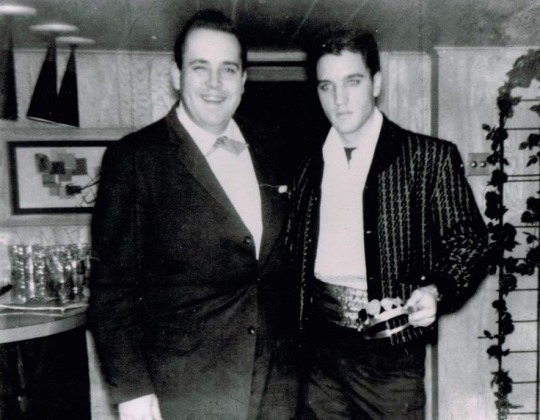
March 20, 1960
Elvis Presley starts his first recordings since being discharged from the US Army. A 12 hour session in a Nashville recording studio produces his next #1 single, “Stuck On You.” Scotty Moore and DJ Fontana, who had quit Presley’s touring band in 1957, are in the studio with him for the last time.
Elvis and his entourage, Scotty and DJ left for Nashville for a recording sessions. They were joined by all musician from the June 1958 session – but not Bill Black who never plays with Elvis again.
Bill Black formed his own combo and opened for The Beatles on their 1964 North American tour.
They worked from 8.00 p.m. to 7.00 a.m. Elvis completed 6 sides for an urgently needed new single, which was pressed and shipped within 2 days, and toward his upcoming album “Elvis is Back”
In the next two days, Elvis records six songs (In true stereo for the first time) including ‘Stuck On You‘ and ‘Fame And Fortune‘ which will be pressed and shipped within two days as an urgently need new single.
#elvisaaronpresley#elvispresley#elvis#graceland#elvis history#elvishistory#tcb#elvis fans#elvis presley#elvis the pelvis#elvis music#elvis the king#60s elvis
48 notes
·
View notes
Text
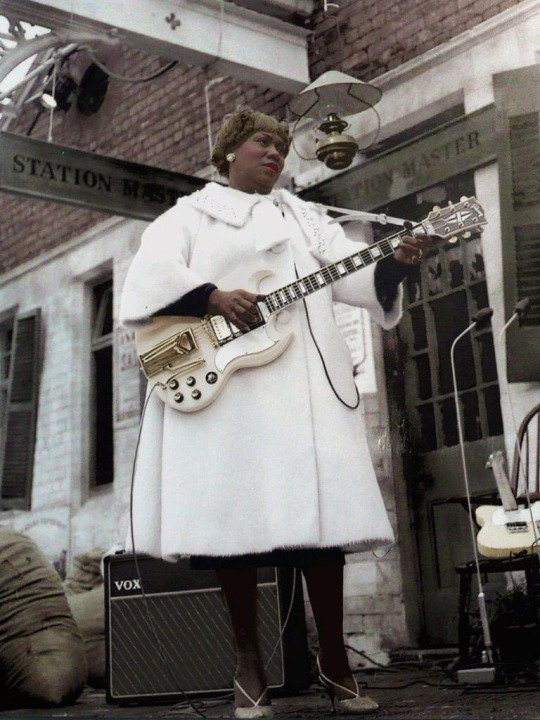
Sister Rosetta Tharpe (born Rosetta Nubin, March 20, 1915 – October 9, 1973) was an American singer and guitarist. She gained popularity in the 1930s and 1940s with her gospel recordings, characterized by a unique mixture of spiritual lyrics and electric guitar. She was the first great recording star of gospel music, and was among the first gospel musicians to appeal to rhythm and blues and rock and roll audiences, later being referred to as "The Original Soul Sister" and "The Godmother of Rock and Roll". She influenced early rock-and-roll musicians including Little Richard, Johnny Cash, Carl Perkins, Chuck Berry, Elvis Presley, Jerry Lee Lewis, and Eric Clapton.
Tharpe was a pioneer in her guitar technique; she was among the first popular recording artists to use heavy distortion on her electric guitar, opening the way to the rise of electric blues. Her guitar-playing technique had a profound influence on the development of British blues in the 1960s. Her European tour with Muddy Waters in 1964, with a stop in Manchester on May 7, is cited by British guitarists such as Eric Clapton, Jeff Beck, and Keith Richards.
In May 2018, Tharpe was posthumously inducted into the Rock and Roll Hall of Fame as an Early Influence.
226 notes
·
View notes
Photo
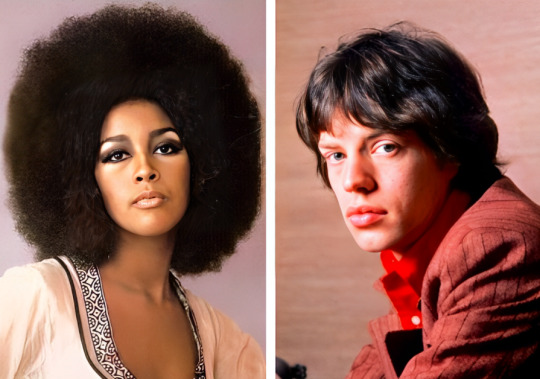
THE FULL HISTORY OF THE MICK JAGGER & MARSHA HUNT (A.K.A.”BROWN SUGAR”) RELATIONSHIP!!!
First, some background on the model, singer, actress, novelist, playwright, activist, icon, 60s goddess, and the woman who inspired one of the Rolling Stones’ greatest hits, “Brown Sugar”, Marsha Hunt. She is often described as London’s own Josephine Baker and is celebrating her 77th birthday today!:
Marsha Hunt was born on April 15, 1946 in Philadelphia, PA and is the youngest of 3 siblings. Her mother, Inez “Ikey” Hunt, worked in an airplane factory during World War II, and her father Blair Hunt Jr. graduated from Harvard and was one of America's first Black psychiatrists.
She was raised mostly by her mother, aunt and grandmother who had roots in the deep south (Mississippi delta) and who she’s described as an “extremely aggressive and ass-kicking independent woman.” Her father later committed suicide when she was 9 years old (but she never found out how or why).
After moving out west to California with her family, she graduated high school at the top of her class and later attended UC, Berkeley in the mid-60s where she wanted to study psychological anthropology.
While at Berkeley, she became friends with a slew of interesting people like activist Mario Savio and Huey P. Newton, who later became one of the founders of the Black Panther Party.
[TOP LEFT: Marsha’s mother Inez Hunt; TOP RIGHT: Marsha’s father, Blair Hunt Jr.; BOTTOM LEFT: Marsha at her home in Philly with her father & siblings, Pamala & Dennis; BOTTOM RIGHT: Marsha’s high school graduation photo in 1964.]

Even though she thrived academically and was very involved in student activities, she became bored with college life and wanted to experience life outside of the country and pursue her real passion – music. In early 1966, she sold her car and some books, and trailed off to London with only $1.83 in her pocket.
Around that time, London was THE city to be in, and was even dubbed “Swinging London” for being the epicenter of art, culture, fashion and of course music, especially due to the popularity of famous acts like the Beatles and the Rolling Stones.
When Marsha first arrived, she slept on the floors of mutual friends, took odd jobs (including one as an au pair), and even appeared as an extra in Michelangelo Antonioni's box office hit film, “Blow-Up,” which also featured the British rock band, the Yardbirds.
SHOCKINGLY, in that same year she actually saw the Rolling Stones for the first time during their UK tour at the Royal Albert Hall in London because she wanted to see Ike & Tina who were the supporting act on the bill. Girls were going crazy over the Stones, but of course, she was more impressed by Tina’s show-stopping performance! (Purrrrr 💅🏿)
[LEFT: Marsha in 1966; RIGHT: The Rolling Stones performing at the Royal Albert Hall in London with Marsha in attendance.]

After roaming the city, making new friends and trying to find steady work, Marsha ended up auditioning for a blues band fronted by British blues musician, Alexis Korner, who was looking for backup singers. Coincidentally, he was the exact same guy who gave the Rolling Stones their start back in 1962. Later on, she was offered another backing gig for Long John Baldry’s band, Bluesology. John is also a longtime friend of the Beatles and the Rolling Stones.
Though she loved music and worked really hard at it, Marsha always claimed that she was never a good singer. People in England just assumed she was because they thought all Black Americans had talent.
She then lived with English blues singer, John Mayall, who actually wrote a few songs about her including, “Marsha’s Mood” and another song coincidentally called “Brown Sugar”. Around this time, she also became good friends with the founding members of Fleetwood Mac, famed British artist Kaffe Fassett, and keyboard player for Bluesology, Reg Dwight (a.k.a Elton John).
[LEFT: 19 year old Marsha sporting a wig in London; RIGHT: Marsha with a young Elton John].

Around the time Marsha broke things off with John, he was also putting a new band together, which included a young guitarist named Mick Taylor, who showed up at the audition without a guitar. He later became another good friend of Marsha’s.
In late 1966, Marsha met musician Mike Ratledge from the British rock band, Soft Machine. She was having trouble getting a visa extension to stay in England, so they got married on her 21st birthday. She later claimed it was a marriage in name only as they “never held hands and never kissed".
[LEFT: Guitarist Mick Taylor & John Mayall in the mid-60s; RIGHT: Marsha’s “husband” Mike Ratledge of Soft Machine.]

That same year, Marsha’s hair started to fall out from using chemical relaxers, and after wearing wigs for a while, she finally cut it all off and vowed to never straighten it again. Hence, she started sporting her iconic afro hairstyle making her quite a showstopper in London.
In 1968, she found luck when she was cast in a buzzy new rock musical with an ensemble cast called “Hair.” The musical became an instant hit in London’s famed West End. And even though her character “Dionne” only had two lines, she became the face (or the hair) of “Hair”. The show was a huge success, and also became quite a sensation and social landmark because it highlighted controversial subjects like drugs, casual sex, cursing, nudity, and anti-war rhetoric. While there, she met another close friend, actor Tim Curry.
[BOTTOM: A poster of the hit musical “Hair” that debuted in the Shaftesbury Theatre in the West End, 1968.]
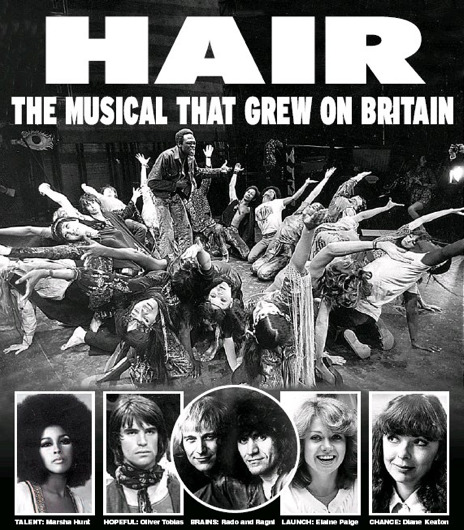
Her life completely changed overnight and she instantly became a PHENOMENON, attracting wide media attention. In fact, after the musical’s opening night, the editor of British Vogue sent her a huge bouquet of flowers and wanted her to pose for a photo session, which ended up being a 4-page spread with a written profile. Marsha was also the first Black woman to appear on the cover of Queen magazine as well.
[LEFT: Marsha pictured as the first Black woman on the cover of Queen magazine; RIGHT: Marsha photographed for British Vogue in 1969.]

She immediately became a sex symbol, celebrity, and the face of the “Black is Beautiful'' movement, which was already taking over America in the mid-60s. This helped her snag lots of modeling gigs and everyone wanted to photograph her. (I mean, sis was booked & busy!!!)
[BOTTOM: More of Marsha’s most iconic shots. *The melanin was melanating, 4C afro was on deck, eyelashes poppin’, lips bussin’...she was a *bad bitch*!!!]

In March 1969, she signed a contract with Track Records, the same independent label that also repped the British rock band, The Who and Jimi Hendrix, and later said, “There was one luxury that London celebrity afforded me: the freedom to be myself without a single apology for my gap, my freaked-out hair, my brown skin, my slave-class ancestors or my radical views.” Around this time, she also had a short love affair with Marc Bolan, the singer and founder of the English rock band, T-Rex (even though he was much shorter than her 😂.)
She scored a few minor hits during her underrated music career with singles like a cover of T-Rex’s “Desdemona” and her debut single, a cover of “Walk on Gilded Splinters”.
[BOTTOM: Marsha performing the T-Rex cover “Desdemona” live in 1970.]

The record soon went to the charts and that spring, she was asked to perform on various shows, including a popular British TV program called, “Top of the Pops” where during her live performance the tight bolero suede top she wore nearly came undone and partially exposed her breasts, giving her the reputation as a “bad girl.”
NOW…Here’s the part y’all have been waiting for. Get your popcorn. Y’all got it? Ready? Good!!! 🍿
After her performance aired, Marsha received a phone call out of the blue from Jo Bergman, the then secretary for the Rolling Stones on behalf of Mick Jagger who was actually watching live, asking her to pose semi–nude for a publicity photo to promote the band’s new single, “Honky Tonk Women”. She said, “The picture was going to be of a girl dressed like a sleaze bag standing in a bar with the Stones and they wanted me to be the girl.”
[BOTTOM: Marsha performing "Walk on Gilded Splinters” on ‘Top of the Pops’ in May 1969. This was also the exact moment Mick Jagger first laid eyes on her!]
dailymotion
Marsha, who was not a Stones fan, was already established and didn’t really need the extra exposure. She declined because she had her reputation to think about and said she "didn't want to look like [she'd] just been had by all the Rolling Stones." She also claimed, “The last thing [Black women] needed was for me to denigrate us by dressing up like a whore” among a band of white men.
ENTER MICK JAGGER:
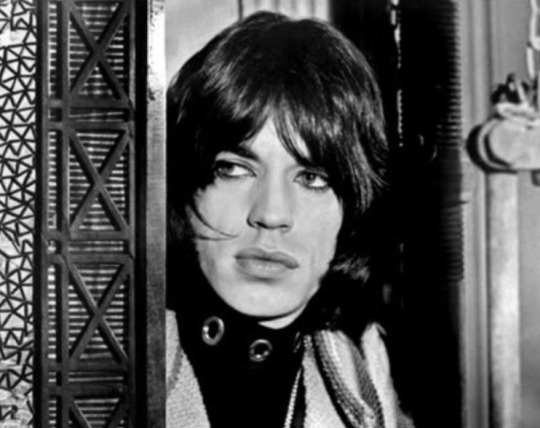
When she tried to get in touch with Mick to say, "thank you, but no thank you”, he later returned her call in an attempt to change her mind and suggested he come over as he was very intrigued that a girl would turn him down.
Mick then showed up at her apartment around midnight as she claims, “He was framed by the doorway as he stood grinning with a dark coat ... He drew one hand out of his pocket and pointed it at me like a pistol. His silly 'Bang' was precisely the icebreaker we needed to get over my ungracious hesitation before I invited him in, not sure how to salute a notorious rogue who rings me just before midnight and suggests he pop round on a pretext of loneliness.”
They talked for HOURS, well until the sun came up about any and everything from music to social issues and politics, and according to her, Mick “made me squeal whenever he used Melanigian slang (aka Black vernacular/AAVE)”. 🙄🤦🏾♀️
Marsha didn’t really find Mick physically attractive at first: “He wasn't beautiful or even striking” however, he was boyish, open, direct, yet seemed quite awkward and shy. She found it a relief that he was nothing like other musicians she’d known or the image the media had of him. He was charming, intelligent, funny, radical and straddled the racial line, much like she did. She also noticed that he had a penchant for Black women, as he claimed “they [Black women] just do something to me”.
The two of them just clicked right off the bat. And things eventually turned hot as they ended up having sex. From there, they embarked on a passionate, but very private, deep romance and year-long affair, at a time when interracial relationships weren’t widely accepted yet.
She didn’t expect to hear from him again, as he had a wide selection of women to choose from, but he wanted to see her and talk all the time because he could count on her. Marsha said, “He knew that I adored him and that he could depend on me…he realized I respected him as I respected myself.”
Mick’s friend and interior designer Christopher Gibbs once said often when he dined with Mick, women who had slept with him would come up to the table and “he’d have absolutely no idea who they were.”
[LEFT: Mick photographed at the Shaftesbury Theatre in London to see the new musical ‘Hair’ for the first time; RIGHT: Marsha performing in the show.]

1969 was a very rough year for Mick. He was having trouble with his band (which he was practically running by himself) because the founder and guitarist of the Rolling Stones, Brian Jones, was becoming increasingly unreliable and spiraling out of control due to his deep drug addiction and legal troubles which led to him having problems getting a US work visa to go on an upcoming tour. His personal life was also a mess because his long-term girlfriend at the time, pop singer Marianne Faithfull, was also a very serious (and sloppy) drug addict, who often embarrassed Mick and became more difficult to be around. Things had gotten so bad between them, their relationship grew strictly platonic by this time.
Mick and Marianne were quite destructive together and often found themselves in legal troubles due to drugs. Marianne was also quite messy as she previously slept with Mick’s bandmates Brian Jones, Keith Richards and even left her husband, John Dunbar, for Mick who was dating Black soul singer & former Ikette, P.P. Arnold, when they met. P.P. later became pregnant with Mick’s baby in 1967, but had an abortion due to his growing relationship with Marianne.
[BELOW: Mick arriving at a courthouse with his then girlfriend, singer Marianne Faithfull in 1969.]
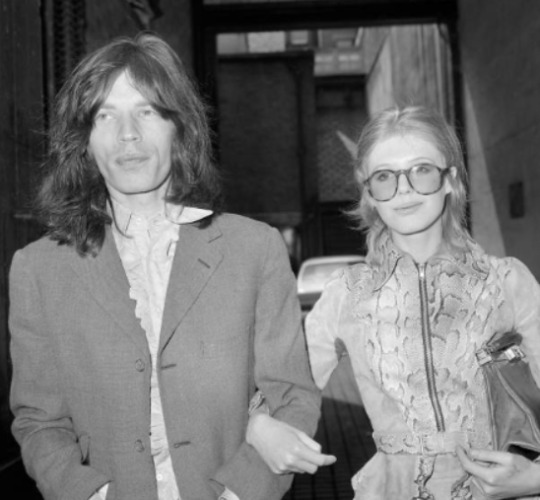
Marsha on the other hand, was stone-cold sober and didn’t do any drugs (NOT ONE), which was like a breath of fresh air for Mick, though he dabbled himself. But unlike those around him, he was able to control his habit.
Even though their relationship quickly turned sexual, they were really, really close friends. Mick often retreated to her home to relax, he told her all his secrets, his troubles – he just trusted her. He was completely enamored of Marsha, who many describe as warm, intelligent, sensitive, funny and very easy to talk to. He liked that she didn’t go gooey-eyed and weak-kneed in his presence like most (white) women/female fans did. Instead she had a crisply forthright manner and was almost quite “butch”. The Rolling Stones then manager was even quoted as saying that Mick was “obsessed” with her as she was very exotic and even gave her the nickname “Miss Fuzzy” due to her afro hairstyle.
Ironically, Marsha enjoyed their well-kept relationship and is one of the only people who often calls him Michael instead of Mick, to distinguish him from his Rolling Stones persona.
Since Marsha was a fellow recording artist, they could also be seen together in public without any arousing suspicion—in any case, London still had almost no paparazzi. They would often go to the same parties or events, even with Mick’s girlfriend there, and no one questioned it.
Mick would often pop into some of Marsha’s studio sessions with her band White Trash, and everyone around would be in awe of him.
After officially firing Brian Jones from the band, Mick and the rest of the Stones needed a new guitarist. Marsha promptly suggested her good friend, Mick Taylor (Yes, Stones fans – thank Marsha Hunt for that one!), as a replacement for Brian just days before his mysterious death (he sadly drowned in a swimming pool at his home) on July 3, 1969.
Additionally, when Mick sought a replacement for Jo Bergman, the secretary who handled all the Rolling Stones affairs, Marsha also suggested her friend and tour manager, Peter Rudge - (The same guy responsible for getting the Stones all those huge tours in massive stadiums. Again, thank Marsha!)
Two days after Brian’s death, the Stones played a free concert before a crowd of over 250,000 people in Hyde Park, London, which was previously planned to debut their new guitarist, but turned into a memorial/funeral for Brian. Mick invited both Marianne (who looked to’ up and was in withdrawal from heroin at the time), and Marsha (who showed up looking sexy af with titties bustin’ out of her buckskin suit) to the concert, and rudely and distastefully opened the show with a song called, “I’m Yours and I’m Hers.”
[BELOW: Mick & Marsha at the Rolling Stones tribute concert to Brian Jones in Hyde Park, London on July 5, 1969.]

Marianne who sat on the other end of the stage with her 4-year old son Nicholas and the other Stones wives/girlfriends, actually saw Marsha that day as she was placed right above the stage in the scaffold VIP section so Mick could look at her while he performed. She later said, “I saw her [Marsha] you know. And she was stunning…If I’d been Mick in that situation, I might have done exactly the same thing.”
Mick arrived at the concert with Marianne, but left with Marsha and spent the night at her place.
A day after the concert, Mick kissed Marsha goodbye, and flew with Marianne to Australia to shoot a biographical film they were both cast in called “Ned Kelly,” based on the infamous bushranger. However, Marianne who was reeling from the recent death of Brian Jones and a horrible miscarriage just a few months earlier, overdosed on 150 Tuinal barbiturates while traveling with Mick and fell into a coma in their hotel room.
[LEFT & RIGHT: Mick & Marianne arriving in Australia to film “Ned Kelly.” Marianne slipped into a coma just hours later from an attempted suicide.]

At the last minute, Mick was forced to film the movie without her, but phoned and wrote to Marsha, who was extremely frantic and worried about his mental health and emotional well-being, almost everyday. She was scared that he didn’t have the stamina to deal with yet another crisis. He sent Marsha over 10 handwritten letters (some even written on the same headed stationery paper of Chevron Hotel where his girlfriend just tried to kill herself) about his deep feelings for her, his experience filming, being in the Australian outback, his interests, the historic day of the moon landing of 1969, future career plans, his regret at missing her performance at the famous Isle of Wight Festival and other aspects of pop culture (including “…John & Yoko boring everybody…”). The letters also reference the recent death of Brian Jones, Mick’s increasingly difficult relationship with Marianne, and another letter even had the full original lyrics for the Rolling Stones song “Monkey Man”, which was later rewritten.
Mick’s letters also went on to mention the foul Australian winter weather and an unpleasant virus that swept through the unit, a fire that destroyed most of the film’s costumes, along with various accidents – including a prop gun that backfired in his right hand. He was just having a real shitty time. So, he found solace writing to Marsha.
His letters to Marsha showed how pensive and romantic he was. He said things like,“... I feel with you something so unsung there is no need to sing it...” and “If I sailed with you around the world, all my sails would be unfurled”. He also thanked her for being “so nice to an evil old man like me”. And in another steamy note, Mick promises Marsha: "I will kiss you softly. And bite your mouth too."
[RIGHT & LEFT: Photos of Mick’s private letters sent to Marsha while filming in Australia in the late summer of 1969.]

Mick also celebrated his 26th birthday while filming in Australia and Marsha sent him a huge package of books (which he loves) and albums, including her friend John Mayall’s record “Brown Sugar.” Along with it was a note stating how she missed him desperately.
While still trying to rehabilitate his hand from the prop accident, Mick toyed with a new guitar and started work on a song, which was partly inspired by Marsha, that he initially titled “Black Pussy.” He decided that was a little too direct and changed it to “Brown Sugar” with the lyrics:
[Verse 1]
Gold coast slave ship bound for cotton fields
Sold in the market down in New Orleans
Scarred old slaver knows he's doing alright
Hear him whip the women just around midnight
[Chorus]
Brown sugar, how come you taste so good?
Uh huh Brown sugar, just like a young girl should
[BOTTOM: Recording of “Brown Sugar” by The Rolling Stones later released on their Sticky Fingers album in 1971.]
youtube
Mick later confirmed in a 1995 Rolling Stone magazine interview that the song is a double-entendre: “brown sugar” being the street name for unrefined heroin and of course – sex with a Black woman. The song was a huge commercial success and ended up becoming a #1 hit around the world, making it one of the Rolling Stones’ best-selling records.
[TOP: A movie poster of “Ned Kelly” which was released in June 1970; BOTTOM: Mick with his guitar composing “Brown Sugar” during filming.]

While Mick was still filming overseas, Marsha was booked to perform at the iconic 3-day outdoor concert, the Isle of Wight Festival on August 30th, 1969. It was the biggest open-air concert in music history and she was the only female singer billed to perform. She was there alongside acts like The Who, Joe Cocker and even Bob Dylan who hadn’t been onstage in 3 years.
Mick told her in a letter that he was so proud of her and promised her that he was “there in my head and in my heart.” Charlie Watts and his wife Shirley, Keith Richards and Jo Bergman were also in the audience watching Marsha perform.
Marsha also wore custom-made leather shorts to which the press ran with it and by the next fashion season, short shorts were featured. She was the first person to popularize “hot pants”.
[BELOW: Marsha performing with her band White Trash at the Isle of Wight Festival on August 30th, 1969 with members of the Rolling Stones looking on in the audience.]

After Mick came back from Australia, Marsha was offered a part in a film called “Welcome to the Club” which is a comedy about three Black USO performers sent to Hiroshima in the 1940s to entertain the troops on an all-white base. The film was being directed by Walter Shenson, who had produced the Beatles' films “A Hard Day's Night” and “Help” and shot it entirely in Copenhagen.
She was also asked to fly back to London to shoot another cover for American Vogue which was shot by photographer Patrick Litchfield. (They‘d never had a Black woman on the cover before.)
Mick began touring in America again, his first since 1966, and with the number of girls he had access to, she knew he was keeping himself busy on and off stage.
[LEFT: Mick on stage at Madison Square Garden during the Stones’ 1969 tour; RIGHT: Marsha filming “Welcome to the Club” in Copenhagen.]

He even started a short-lived relationship with singer and Ikette Claudia Lennear, as well sparking up a short fling with Devon Wilson, a notorious rock & roll groupie and the girlfriend of Jimi Hendrix who famously wrote the song “Dolly Dagger” about their affair.
[LEFT: Mick arriving at Madison Square Garden in November 1969 with Devon Wilson; RIGHT: Mick backstage at the same event with singer Claudia Lennear.]

But on December 6, 1969 - everything changed dramatically when an 18-year old concertgoer was stabbed and killed during the Stones’ free performance at the Altamont Speedway in California by the Hell’s Angels Motorcycle Club, who was the band’s security. Members of the Hell’s Angels blamed Mick for the incident and subsequent to the concert, put a hit out on him and threatened to murder him. This marked the third major tragedy to happen since they’d known each other.
[BELOW: A scared Mick looks on as 18-year old Meredith Hunter is stabbed to death by the Hell’s Angels in front of the stage while the Stones performed at Altamont Speedway.]

Marsha stayed with Mick after the chaos at Altamont, which the media dubbed “The Death of the 60s”. By this time, he had officially split up with Marianne and moved Marsha into his house on Cheyne Walk where she helped him to transition and readjust his life. It was then their relationship intensified!
This is around the time she got a chance to really know Mick’s friends who lived on the same road, Keith Richards and his girlfriend, actress Anita Pallenberg, who just had a son, but was hooked on heroin. She thought they were nice, but they’d visit or show up unannounced all the time. Their hard drug-taking also scared Marsha, so she kept her distance and didn’t voice her opinion.
She also met Mick’s parents, Eva and Joe Jagger, along with his little brother Chris who was a bit of a hippie and had just returned from India with his American girlfriend. They had no work, no money and nowhere to stay, so Marsha kindly gave them a job painting her new apartment.
That Christmas, Marsha got Mick a puppy and Mick, for the first time, told her that he loved her.
Marsha was in a good place. Opportunities were coming to her fast, she had a new apartment, and she was in love with Mick. She had newfound stability and independence.
In January 1970, they were having dinner at the celebrity hotspot restaurant Mr. Chow’s when Mick said that she’d be a good mother and that they should have a baby together. Prior to this Marsha thought she was just another girl he fancied, as he was a notorious womanizer. But the talk of having a baby made her feel special to him. Her feelings for him were so deep that she also claimed, “I would have died for him.”
She knew Marianne miscarried around the same time Keith Richards’ son Marlon was born. Mick also missed family life with Marianne’s son Nicholas, so wanted to give having a baby a second try.
This fool literally made her take out her IUD coil, they had sex like rabbits, and when she found out she was 3 weeks pregnant, she told Mick who was ecstatic.
Marsha literally said to him, “listen, if you’re not ready and you changed your mind about this, it’s okay.” She was totally ready to get an abortion. But he assured her that’s what he wanted and he was happy.
They had their first argument when it came to naming the baby. Mick wanted a boy who he could send to the prestigious Eton School (the all-boys school where Prince William & Prince Prince Harry went), and he proposed that they call the baby ‘Midnight Dream’. Marsha wasn’t having it and even said, “Imagine sticking your head out of a window to call your child home and yelling, 'Midnight. Midnight! Time for tea.’”
She'd known that he and the band were leaving England for tax reasons and moving to France in the coming year. The Stones were also gearing up for their upcoming European tour.
Even though she loved Mick, he was young and she claimed she was “all for Mick doing his own thing”. They were supposed to be the sophisticated embodiment of an alternative social ideal — parent-hood shared between loving friends living separate lives.
This was around the time of the sexual revolution and people were exploring different types of relationships. Marsha didn’t find gratification in being ‘Mr. So and So’s’ wife, plus Mick was the type of guy to get up at 2pm to start his day - so marriage was sort of off the table. She claimed their relationship “thrived off her being supportive” and she loved to see him “run free”. And since she grew up in a matriarchy, the ideal of a man and woman living together seemed nice but unnecessary. They agreed that Mick would be a good absent father while he toured with the Rolling Stones and Marsha could still have her own career. It was all very modern!
Marsha also feared that her association with Mick would crowd out her own identity. She didn’t like the limelight because it was a discomfort. She also never wanted to be known as Mick Jagger's girlfriend (can you blame her? Like two of his girlfriends tried to commit suicide). Like him, she wanted her own independence.
By June 1969, Marsha told her band and the press that she was pregnant, but did not give up the name of the father. Though one little clever reporter found out it was Mick and threatened to print it. She thought of suing but asked the Stones PR team to link him to another girl. She managed to get through her pregnancy without a media frenzy or being linked to Mick even though they had stepped out together many times and he was ready to have it reported.
While Mick was away touring in Europe, his phone calls got less frequent. The tour was a bit crazy, and although Mick invited her to go to Paris, he knew she'd refuse – she didn’t want to get caught up. But he told her he was lonely and had met someone in Paris that he was taking to Italy. Her name was Bianca. She was Nicaraguan and spoke little English. Mick didn't mention her again, but after the tour, Marsha knew that she moved to his house in England.
His publicist sent her an invite to the premiere of his corny movie, “Ned Kelly,” but he didn’t show up. He also invited his parents to the event and it was there she realized that he didn’t tell them that he had a baby on the way. Mick hardly lavished praise on his parents and even once told the press, “I owe them nothing. They are my parents, that is that…but there are no dues to be made by me to them!”
By her third trimester, having a baby became her whole reality and his passing fancy. He started to forget that the baby was HIS idea.
Despite Marsha carrying his child, practically all references to her and the baby were quickly airbrushed out of his life. Chris O'Dell, Mick’s PA in the early-70s was even quoted as saying, “I never remember him talking about their child. In fact, I wasn’t aware of a baby being around at all. It was almost like [his first child] didn’t exist.”
Marsha was put in a difficult position because it was too late to go back and sometimes he’d phone like nothing ever happened. She claimed his mood would change so quickly, he was like Dr. Jekyll and Mr. Hyde. She also said, “I've discovered that he can burn hot and suddenly cool to below zero.“
She started to worry that he didn’t care anymore, so she tried to squeeze in any and every piece of work she possibly could to hold her up during and past her pregnancy (tv shows, photoshoots, etc.). She also volunteered at a local mental-care center in the autistic unit caring for a 12 year old boy to keep from feeling useless.
[BELOW: A heavily pregnant Marsha performing in late 1970.]

At the same time, Mick also did a lot of peculiar interviews, either stating he wasn’t interested in having children or flat out dissing Marsha. During a 1970 interview with London’s Daily Mail newspaper he even said, “For me, life has always got to be on the move and exciting. I love kids, I really do…but it’s not something I’m thinking about.” He of course failed to mention that Marsha was expecting their first child.
[BELOW: Mick during an interview referencing Marsha & his unborn child in 1970.]

Once it was time for her to give birth, a hard-up Marsha was ashamed and reluctant to ask him for any contribution because he never once offered. Mick ultimately gave her a measly £200 to get by, which came with a note saying “I know I haven’t done right by you” and he “loaned” her a ring he always wore.
She had initially planned a natural home delivery to keep the press at bay and because it was the “it” thing to do at the time, but was told by her OB-GYN that her baby was in danger and she had to go to the hospital the next day.
On November 3rd, she dragged her own luggage, and hailed a taxi to the hospital only to be told there weren’t enough beds. Panicked and scared, she went back home quite sure she was going to die from an unassisted childbirth.
When she went back to the hospital the next day for an induced labor, she checked in with her married name “Ratledge” to protect herself (and Mick). On November 4, 1970 after hours of labor, she gave birth to a girl she named Karis Hunt and phoned Mick first and then her mother. That day was the first time Mick actually told his now girlfriend Bianca that Marsha and a baby existed.
While waiting in the maternity ward, the nurses also forgot to feed her and she was so hungry. But being on The National Health, she didn’t complain.
When she checked out of the hospital, Mick sent a bouquet of red roses, a miniature muse figurine for the baby, a silver spoon, and some cheap Indian earrings for Marsha. He “dropped by” two days later to see his baby but was in a hurry to be somewhere else.
10 days later, he paid another rushed visit, but she took him to the side and was kinda like, “What’s up with you? Why don’t you call or come around more often for the baby” in which he snapped and yelled at her, “I never loved you” and that she was “mad to think that he had”. Of course Marsha, stitches still in, burning and all, started to cry which only made him more mad and he threatened to take Karis away from her if he chose. She stopped and said, “Try it! I’d blow your brains out!!”
In that moment, the loyalty she had for him was gone and she pushed forward and tried to find as much work as she could to support herself and her baby.
[BELOW: Marsha & Mick after the birth of their first child Karis Hunt in late 1970.]

READ ‘PART 2’ HERE!!! ☕️☕️☕️
#marsha hunt#mick jagger#the rolling stones#brown sugar#rolling stones#interracial couple#black women#karis jagger#music#history#rock history#rock & roll#musicians#thread#gossip#old school tea#1960s#1970s#sbrown82
275 notes
·
View notes
Text
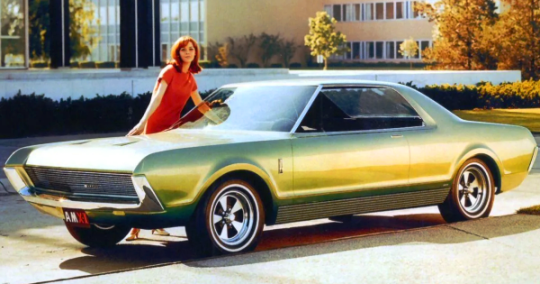
Outside the AMC Box: 1966 American Motors AMX II Concept
Posted on March 19, 2024 by MCG
To create the AMX II, AMC design chief Richard Teague reached outside his own styling studios and brought in independent designer and builder Vince Gardner.
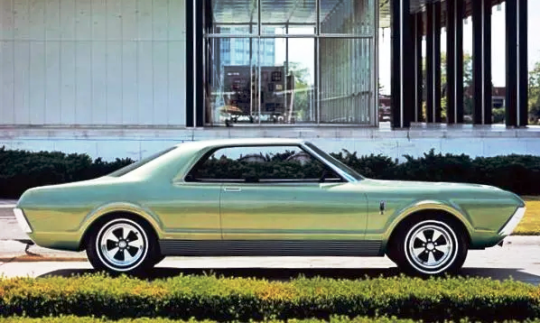
In his long tenure as vice president of design at American Motors from 1964 to 1983, Richard A. Teague earned a reputation for working outside the box. This constant drive to be different could be seen, for example, in the four Project IV concept vehicles his design staff prepared for a 1966 promotional tour, with displays in six major American cities. For one of the Project IV cars, the AMX II, Teague reached outside the box a little further and brought in an independent designer, Vincent E. Gardner.

Among car designers, Vince Gardner had a remarkable skill set. In addition to being a talented stylist, he was also a highly capable clay modeler and fabricator. As a kid fresh out of high school, he prepared the clay model for the 1936 Cord 810, working alongside designer Gordon A. Buehrig. His own design credits include the 1947 Gardner Special, the 1953 Vega sports car, and the 1964 Mustang III, while the 1962 Thunderbird Italien and 1968 Dodge Charger III are among the concept vehicles he constructed for the automakers.
While the AMX II was Gardner’s creation, it didn’t look at all out of place among the other three Project IV concept vehicles, integrating nicely. (See our feature on the Project IV Cavalier here.) According to the American Motors press materials, the AMX II was intended to expand on the theme of the AMX sports car concept, which made its public debut in the Project IV program
Eight inches longer than the AMX, the AMX II included room for four passengers and a generous trunk. (AMX stood for American Motors eXperimental.) Though it almost doesn’t look it, the wheelbase was a full 110 inches, with a shape that could remind you of the 1967 Mercury Cougar, though it’s slimmer, less chunky.

Features included hidden headlamps and windshield wipers, while an automated circuit locked the doors when the AMX II was moving. At the rear was was a safety tail lamp arrangement with green, yellow, and red segments for driving, slowing, and braking. However, it seems many of these features probably existed only on paper.
Like the other Project IV cars, the AMX was not a running vehicle, but merely a fiberglass studio glider with no drivetrain or running gear. There was no real interior, either, only a black sillhouette panel inside, just under the beltline, to fill the cabin volume. Like so many pushmobile show cars, the AMX II served no real function once its display career was concluded, so it was more than likely scrapped soon after.

44 notes
·
View notes
Text
Victoria Spivey

Victoria Regina Spivey (October 15, 1906 – October 3, 1976), sometimes known as Queen Victoria, was an American blues singer, songwriter, and record company founder. During a recording career that spanned 40 years, from 1926 to the mid-1960s, she worked with Louis Armstrong, King Oliver, Clarence Williams, Luis Russell, Lonnie Johnson, and Bob Dylan. She also performed in vaudeville and clubs, sometimes with her sister Addie "Sweet Peas" (or "Sweet Pease") Spivey (August 22, 1910 – 1943). also known as the Za Zu Girl. Among her compositions are "Black Snake Blues" (1926), "Dope Head Blues" (1927), and "Organ Grinder Blues" (1928). In 1961, she co-founded Spivey Records with one of her husbands, Len Kunstadt.
Born in Houston, Texas, she was the daughter of Grant and Addie (Smith) Spivey. Her father was a part-time musician and a flagman for the railroad; her mother was a nurse. She had three sisters, all three of whom also sang professionally: Leona, Elton "Za Zu", and Addie "Sweet Peas" (or "Sweet Pease") Spivey (August 22, 1910 – 1943), who recorded for several major record labels between 1929 and 1937, and Elton Island Spivey Harris (1900–1971). She married four times; her husbands included Ruben Floyd, Billy Adams, and Len Kunstadt, with whom she co-founded Spivey Records in 1961.
Spivey's first professional experience was in a family string band led by her father in Houston. After he died, the seven-year-old Victoria played on her own at local parties. In 1918, she was hired to accompany films at the Lincoln Theater in Dallas. As a teenager, she worked in local bars, nightclubs, and buffet flats, mostly alone, but occasionally with singer-guitarists, including Blind Lemon Jefferson. In 1926 she moved to St. Louis, Missouri, where she was signed by Okeh Records. Her first recording, "Black Snake Blues" (1926), sold well, and her association with the label continued. She recorded numerous sides for Okeh in New York City until 1929, when she switched to the Victor label. Between 1931 and 1937, more recordings followed for Vocalion Records and Decca Records, and, working out of New York, she maintained an active performance schedule. Her recorded accompanists included King Oliver, Charles Avery, Louis Armstrong, Lonnie Johnson, and Red Allen.
The Depression did not put an end to Spivey's musical career. She found a new outlet for her talent in 1929, when the film director King Vidor cast her to play Missy Rose in his first sound film, Hallelujah!. Through the 1930s and 1940s Spivey continued to work in musical films and stage shows, including the hit musical Hellzapoppin (1938), often with her husband, the vaudeville dancer Billy Adams.
In 1951, Spivey retired from show business to play the pipe organ and lead a church choir, but she returned to secular music in 1961, when she was reunited with an old singing partner, Lonnie Johnson, to appear on four tracks on his Prestige Bluesville album Idle Hours.
The folk music revival of the 1960s gave her further opportunities to make a comeback. She recorded again for Prestige Bluesville, sharing an album, Songs We Taught Your Mother, with fellow veterans Alberta Hunter and Lucille Hegamin, and began making personal appearances at festivals and clubs, including the 1963 European tour of the American Folk Blues Festival.
In 1961, Spivey and the jazz and blues historian Len Kunstadt launched Spivey Records, a low-budget label dedicated to blues, jazz, and related music.
In March 1962, Spivey and Big Joe Williams recorded for Spivey Records, with harmonica accompaniment and backup vocals by Bob Dylan. The recordings were released on Three Kings and the Queen and Kings and the Queen Volume Two. Dylan was listed under his own name on the record covers. A picture of her and Dylan from this period is shown on the back cover of the Dylan album, New Morning. In 1964, Spivey made her only recording with an all-white band, the Connecticut-based Easy Riders Jazz Band, led by the trombonist Big Bill Bissonnette. It was released first on an LP and later re-released on compact disc.
Spivey married four times; her husbands included Ruben Floyd, Billy Adams, and Len Kunstadt.
Spivey died in New York on October 3, 1976, at the age of 69, from an internal hemorrhage.
34 notes
·
View notes
Text

In the childhood memories of more than one generation, Glynis Johns, who has died aged 100, will be best remembered as the Edwardian materfamilias of the hugely popular Walt Disney musical Mary Poppins (1964). Winifred Banks, married to David Tomlinson’s George W Banks, is the mother of Jane and Michael, the children in the care of the magical nanny played by Julie Andrews. A protester for the right to vote, Winifred delivers a spirited rendition of the song Sister Suffragette – “Our daughters’ daughters will adore us. And they’ll sing in grateful chorus: ‘Well done, Sister Suffragette!’” – as the children’s previous nanny tries to quit.
But the husky-voiced actor had other claims to fame from her more than 60 films and 30 stage productions. In 1973, Stephen Sondheim composed the song Send in the Clowns for Johns when she was cast in the leading role of the premiere production of his musical A Little Night Music, on Broadway. And she had won initial stardom in the British cinema as a mermaid.
In the title role of the film comedy Miranda (1948), she travels from Cornwall to London and causes romantic complications among the Chelsea set. Although the film’s whimsy may now seem strained, it was a great commercial success in its day, making Johns a top-liner in British movies. Miranda returned in a rather belated sequel, Mad About Men (1954).
By that time, Johns had moved almost completely from stage to films, where she was associated chiefly with lightweight roles, alternately fluffy and feisty. One of her most appealing opportunities came in the thriller State Secret (1950, released as The Great Manhunt in the US), playing a cabaret artiste in a fictitious Balkan country, and gamely singing Paper Doll in a wholly invented language.
It says something for her properties of youthfulness that at the age of 30 she could play a teenage schoolgirl in the melodrama Personal Affair (1953). The same year she played in two fanciful Walt Disney British productions, as Mary Tudor in The Sword and the Rose, and as the heroine wife of Rob Roy, and she went on to make her first Hollywood picture, the Danny Kaye comedy The Court Jester, in 1955. The following year she played a cameo role in the star-studded Around the World in 80 Days.
At the time Johns alternated between American and British films, generally in subordinate roles, but a rewarding one came in The Sundowners (1960), set in Australia, as a jolly barmaid who takes a shine to a visiting Englishman played by Peter Ustinov. It brought her an Oscar nomination as best supporting actress. Top billing came in a stylish horror movie, The Cabinet of Caligari (1962). She was well enough known to American audiences by this time to star in 1963 in Glynis, a TV sitcom series that ran for just one season.
In 1966 Johns returned to the London stage in The King’s Mare, as Anne of Cleves to Keith Michell’s Henry VIII. Her Welsh heritage came into play when she took the role of Myfanwy Price in a screen version of Dylan Thomas’s Under Milk Wood (1971) starring Richard Burton, Elizabeth Taylor and Peter O’Toole, and two years later came her great Broadway success as Desiree Armfeldt in A Little Night Music, which brought her a Tony award.
Glynis came from a show business background: her mother, Alice Steele (nee Wareham), was a concert pianist who performed under the name Alys Steele-Payne, and her father was the prolific character actor Mervyn Johns. He was a stalwart in particular of Ealing Studios films: father and daughter appeared together in an Ealing drama, The Halfway House (1944).
Though her vocal intonations pointed to her Welshness, Glynis was born in Pretoria, South Africa, where her parents were on tour. She was reportedly carried on to the stage at the age of three weeks, and it was not too much longer before she was appearing there in a professional capacity, making her performing debut at the Garrick theatre, London, as a dancer in a revue called Buckie’s Bears (1935).
Educated at Clifton high school, Bristol, and South Hampstead high school and the Cone School of Dancing in London, she rapidly graduated to juvenile acting roles in both theatre and cinema. Her first screen appearance came at the age of 14, as politician Ralph Richardson’s troublesome daughter in South Riding (1938), and on stage she was the young sister, another Miranda, in Esther McCracken’s comedies Quiet Wedding (1938) and Quiet Weekend (1941).
That year brought the opportunity to appear in the film 49th Parallel, starring Leslie Howard and Laurence Olivier in a spy thriller intended to bolster second world war support in the US. When the prospect of playing a mermaid came after the war, she was able to draw on her theatrical versatility: “I was quite an athlete, my muscles were strong from dancing, so the tail was just fine. I swam like a porpoise.”
Johns returned to the London stage in 1977, as Terence Rattigan’s choice to play the murderer Alma Rattenbury in his well-received dramatisation of the Rattenbury case, Cause Célèbre. Her acting appearances became sporadic, though in 1989 she starred with Rex Harrison and Stewart Granger on Broadway in Somerset Maugham’s The Circle.
She was occasionally a guest star in US television series such as Murder She Wrote and The Love Boat, and played Diane’s rich mother, Helen Chambers, in the first series of Cheers (1983) and Trudie Pepper in the sitcom Coming of Age (1988-89). By the time of her final films, While You Were Sleeping (1995) and Superstar (1999), she was a characterful grandmother.
Johns was married and divorced four times. Her first husband, from 1942 to 1948, was the actor Anthony Forwood. Their son, Gareth, also an actor, died in 2007. Marriages to two businessmen followed: David Foster, from 1952 to 1956, and Cecil Henderson, from 1960 to 1962. She was married to Elliott Arnold, a novelist, from 1964 to 1973, and is survived by a grandson and three great-grandchildren.
🔔 Glynis Margaret Payne Johns, actor, born 5 October 1923; died 4 January 2024
Daily inspiration. Discover more photos at Just for Books…?
40 notes
·
View notes
Text
Today we venerate Elevated Ancestor El-Hajj Malik El-Shabaz aka Brother Malcolm "X" Little on his 98th birthday 🎉
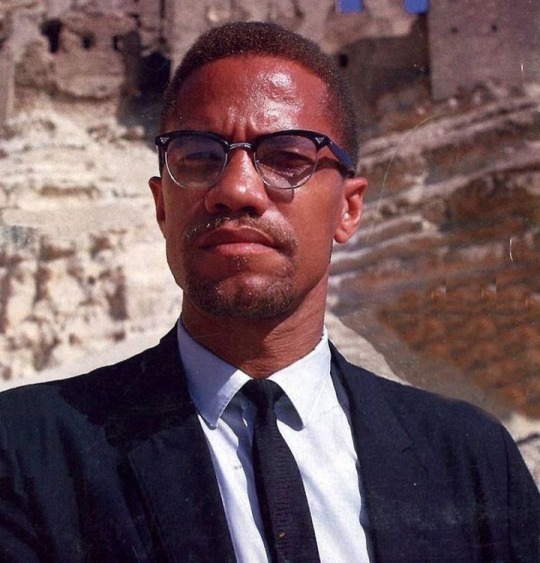
A minister, scholar, orator, & legendary Freedom Fighter- who infamously bore the name "X" to signify our self-liberation from the shackles of a European legacy forced upon us during Slavery -, we elevate Brother Malcolm as one of THE most prolific voices of freedom, justice, self-determination, & Pan-Afrikan unity in modern history.
Born into a legacy of freedom fighters, Brother Malcolm was raised on the cusp between Black Nationalism unity & White Supremacist terror. His father was a member of Marcus Garvey’s Universal Negro Improvement Association (UNIA), in which he served as an orator publicly advocating for Black liberation before his murder.
Though a gifted student, Malcolm dropped out of school when a teacher ridiculed his aspirations to become a lawyer. He later drifted into a life of hustling on the streets of Harlem. He cleverly avoided the draft in WWII by making the outrageous declaration that he'd organize Black soldiers to attack their White counterparts which classified him as "mentally unfit to serve". After his burglary arrest in Boston, Malcolm faced 10 years in prison. Here, he found Islam via the NOI.
Upon his parole release, Malcolm took the name "X" as he began to serve in the NOI as a speaker, organizer, and minister. He quickly grew in his prominence & drew national attention after an expose on the NOI was aired on CBS. Both, Black & White Americans, saw the stark contrast in his/NOI views from that of other Black religious leaders/organizations of the time. Thus planting the first seeds of warped perception & fear.
Meanwhile, Brother Malcolm's personal views & interests slowly began to split from the leaders of the organization he'd come to love. Malcolm grew increasingly frustrated with the NOI's bureaucracy & outright refusal to join the Civil Rights Movement. His forbidden response to the assassination of JFK earned him a 90 suspension from the NOI; at which time he announced his departure from the organization.
In March 1964, he founded the Muslim Mosque, Inc. Three months later, he founded a political group called, the Organization of Afro-American Unity (OAAU). Malcolm firmly placed Black Revolution in a global context of an anti-imperialist struggle here, in Afrika, Latin America, & Asia. This is what set him & his work further apart from any Black leader & organization in the U.S. at the time. And this is what sparked the breadth of his influence & mapped out the future of his work.
Brother Malcolm toured North & East Afrika as well as the Middle East Region in the late Spring of 1964. He met with heads of state from several countries (i.e.: Kenya, Tanzania, Egypt, Ghana, Nigeria) before making his hajj to Mecca, Saudi Arabia. Here, he added "El-Hajj" to his Muslim name, "Malik El-Shabazz". This journey into the Motherland & Self brought Malcolm to the realization that his revolutionary vision/influence superceded any colour line.
Once he returned to the U.S, he infamously declared Pan-African unity amid struggle for freedom “by any means necessary.” This marked a turning point in Malcolm's life & revolutionary fight against White Supremacy on a global scale. He spent 6, albeit unsuccessful, months in Afrika petitioning the U.N. to investigate the Human Rights violations of Black Americans by the U.S. Government. From then on, threats to his safety and that of his family & the OUAA mounted. Still, he continued the fight until his assassination that was ultimately orchestrated & carried out by the CIA.
"If you’re not ready to die for it, put the word ‘freedom’ out of your vocabulary" - Malcolm X
Today, Brother Malcolm rests alongside his wife at the Ferncliff Cemetery in upstate NY.
We pour libations & give him💐 today as we celebrate him for his incomparable leadership, love, commitment, & sacrifice for the socioeconomic & sociopolitical freedom of our people.
Offering suggestions: libations of water, read/share his work, & prayers from the Quran
Note: offering suggestions are just that & strictly for veneration purposes only. Never attempt to conjure up any spirit or entity without proper divination/Mediumship counsel.
#Hoodoo#hoodoos#atr#atrs#hoodoo tradition#the hoodoo calendar#black history#malcolm x#malcolm x day#by any means necessary#freedom fighters#civil rights movement#freedom ain't free
80 notes
·
View notes
Note
Hello! Can you recommend any mcharrison fics? Preferably ones in which George bottoms? Or Paul doesn't bottom? I've only read ones in which he does and I'd like to read smth different. Thank you.
Thank you so much for asking. I'm not a big reader of mcharrison yet, and the 'no Bottom Paul' stipulation added another challenge!
But here are some fics I love that hopefully fit what you are looking for. If any mcharrison expert has more recommendations: please add them. <3
our bodies possessed by light (tell me we'll never get used to it) (hey_dorothea): Paul POV. George and Paul discover a new side to their relationship during a business meeting with Maharishi in Sweden. I love that neither of them is a 'virgin with men' when they do. This writer also wrote a novel-length fic about George and Paul, which I haven't read, but if you enjoyed this story, it might be for you.
A Wrench in Clocks (honeyheffron): To quote from the summary: Paul, John, George—forth and back, and all the ways they fit together. This ends with George and Paul together. The scene where George bottoms for Paul while John is...there (sorry, John) is one of the hottest things I read, full stop.
This also goes for No I in Threesome (@with-eyes-closed), also a John/George/Paul triangle story, this one set at the height of Beatlemania, amidst the howling chaos and merciless grind of touring, with relentless, painfully hot sexual energy between all of them— esp. George and Paul. Paul is very much not a bottom here.
Much shorter, but equally potent: Taking Control (@ohjohnnysblog). Paul discovers he likes it when George takes control.
Sherlock Starr (Anonymous): On tour. George and Paul get each other off—and George reminds Paul he doesn't always have to do all the work. Inspired by a very interesting photo!
sorry about the blood in your mouth (I wish it was mine) (stargiirl27). Hamburg. George and Paul fight, and then fuck. They like it. They lie there together, disgusting and bloody and covered in come. Plus protesting German neighbors.
Years Since it's Been Clear (@boshemians): Strictly speaking not mcharrison, but Paul & George, but a great relationship story nonetheless. Similar to:
Hear Them Say (@boshemians): George is sick before the Beatles' American TV debut in 1964. This is about George's relationship with the band as a whole, and with John and Paul separately, with mclennon in the background (and—discreetly!—in the next bed), but I'm putting it here because I enjoy the George POV a lot.
(as always, I don't know everyone's tumblr, so feel free to let me know so I can tag where appropriate. Thank you.)
14 notes
·
View notes
Text
youtube
For most people, House of the Rising Sun evokes memories of the 1964 hit The Animals. The song itself, however, has a hidden and shockingly extensive history that began much earlier than the mid-1960s.

The melody itself is a traditional English ballad, but it has become popular as an African American folk song. It was recorded by Texas Alexander in the 1920s, then by a number of other performers, including Ledbelly, Woody Guthrie, Josh White and later Nina Simone.
But it was Nina's version that The Animals heard.
No one can claim the rights to the song, which means that it can be recorded and sold without royalties. But many bands made covers of it after it became a hit with The Animals.
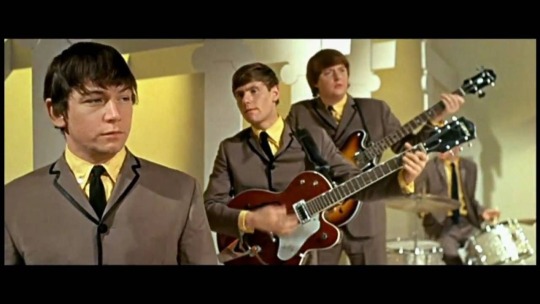
Historians have not been able to definitively identify what the "House of the Rising Sun" is, but here are two of the most popular theories:

1.This song is about a brothel in New Orleans. The House Of The Rising Sun was named after its owner, Madame Marianne Le Soleil Levant (which means "Rising Sun" in French). The brothel operated from 1862 to 1874, and then closed due to complaints from neighbors.

2.We are talking about a women's prison in New Orleans called the Orleans Parish Women's Prison, the entrance gates of which were decorated with paintings of the rising sun. This could explain the phrase from the song "ball and chain".
Ethnomusicologist Alan Lomax recorded his version of the song in 1937 with a 16-year-old girl named Georgia Turner. In this context, the song is sung in the first person in the present tense, when the singer laments how the House of the Rising Sun destroyed her life. In this traditional folk version, the main character is either a prostitute or a prisoner. The Animals changed the character to a gambling enthusiast to make their version more suitable for radio.

In 1964, this folk song became a worldwide hit for The Animals. Their version reached number one in the UK on July 9, and in America on September 5.
Animals vocalist Eric Burdon explained in a 2010 interview for Songfacts:
House of the Rising Sun is a song that I was just destined to perform. She was made for me, and I was made for her. It was a great song to tour with Chuck Berry because it became a way to reach the audience without copying Chuck Berry himself. It was a great trick, and it worked. In fact, not only a trick, but also a great record.

Bob Dylan included this song on his first album in 1962 with a folk arrangement like that of American folk singer Dave Van Ronk. When The Animals recorded it two years later, it transformed Dylan. The musician realized that he could apply a rock rhythm to a folk song. Bob bought an electric guitar and started playing it, which made him famous at the Newport Folk Festival in 1965, where he performed an electric set for the first time.
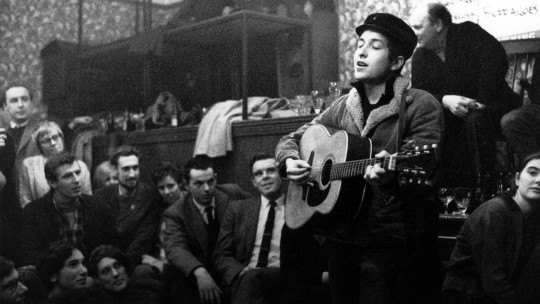
The Animals recorded the song in the studio in just one take, as they honed it by constantly performing on tour. John Steele, the band's drummer, recalled this.:
On May 17, 1964, we played in Liverpool, and then went to London, where Mickey Most booked a studio for the ITV show Ready Steady Go! Because of the reaction we got to Rising Sun, we asked to record this song as well, to which he said, "OK, we'll do it in the same session." We tuned in, played a few bars for the sound engineer – it was mono without overdubs – and recorded it only once. After listening, Mickey said: "That's it, it's a finished single." The sound engineer said that the song came out too long, but instead of shortening it a little, Mickey plucked up the courage and said, "Now we live in a microgrove world, we'll release it." A few weeks later, the song became No. 1 worldwide. When we knocked the Beatles off the top in America, they sent us a telegram that read: "Congratulations from The Beatles (band)."
Producer Mickey Most added:
Everything was in the right place, the planets were in the right place, the stars were in the right place, and the wind was blowing in the right direction. It took only 15 minutes to record, so I can't take much credit for producing it. It was just an incident that captured the atmosphere in the studio.

My old collection of cover version


#animals#bob dylan#nina simone#Georgia Turner#Lonnie Johnson#music story#history music#my music#music#music love#musica#spotify#my spotify#rock#rock music#rock photography#eric burdon#alan price#chas chandler#hilton valentine#john steel#love music#music lovers#The House Of The Rising Sun#musicians#Youtube#Spotify#cover
10 notes
·
View notes
Text
THIS DAY IN GAY HISTORY
based on: The White Crane Institute's 'Gay Wisdom', Gay Birthdays, Gay For Today, Famous GLBT, glbt-Gay Encylopedia, Today in Gay History, Wikipedia, and more … December 14

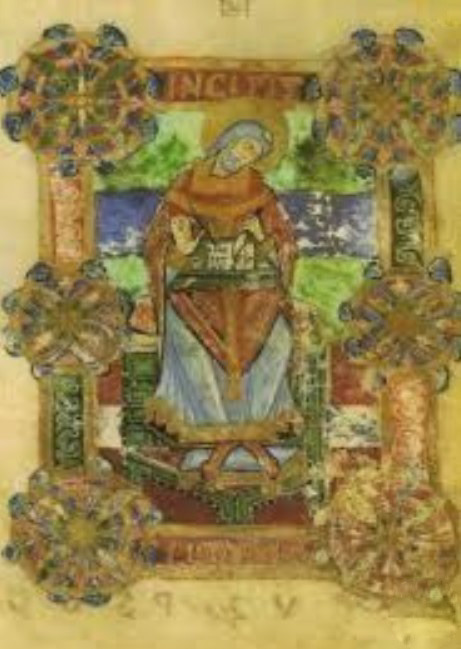
c.530 – Venantius Fortunatus (d.circa 600/609) was a Latin poet and hymnodist in the Merovingian Court, and a Bishop of the early Catholic Church. He was never canonised but was venerated as Saint Venantius Fortunatus during the Middle Ages.
Born in Treviso, near Ravenna in Italy, he spent his time as court poet to the Merovingians. After visiting the tomb of St. Martin of Tours at St. Hilary at Poitiers, he decided to enter a monastery.
He continued to write poetry, some of which have a permanent place in Catholic hymnody, for instance the Easter season hymns "Vexilla Regis" and the "Pange Lingua" (Sing, O my tongue, of the battle). Three or four years before he died he was made bishop of Poitiers. Although never canonized, he was venerated as a saint in the medieval church, and his feast day is still recognized on 14th December each year.
Like Paulinus of Nola, St Venantius's poetry also includes some decidedly secular verse of the romantic sort. That this celebrates male love is clear from its inclusion in the Penguin Book of Homosexual Verse.
"Written on an Island off the Breton Coast"
You at God's altar stand, His minister
And Paris lies about you and the Seine:
Around this Breton isle the Ocean swells,
Deep water and one love between us twain.
Wild is the wind, but still thy name is spoken;
Rough is the sea: it sweeps not o'er they face.
Still runs my lover for shelter to its dwelling,
Hither, O heart, to thine abiding place.
Swift as the waves beneath an east wind breaking
Dark as beneath a winter sky the sea,
So to my heart crowd memories awaking,
So dark, O love, my spirit without thee.
Fortunatus died in the early 600s. He was called a saint after his death, but was never formally canonized.


1791 – Today is the birthday of the Irish poet Charles Wolfe (d.1823). Born at Blackhall, County Kildare, Wolfe attended Trinity College, Dublin between 1809 and 1814 and was ordained as a Church of Ireland priest in 1817. He is remembered for his poem "The Burial of Sir John Moore after Corunna", written in 1816 and much collected in 19th and early 20th century anthologies.
Wolfe's sexuality is often disputed, many believe he was homosexual. He certainly had an extremely intense friendship with the Rev. Thomas Meredith for whom he wrote two gushing epithets. Wolfe died from tuberculosis caught from a cow at the age of 32. Yes. A cow. Even into the mid-20th century tuberculosis was commonly transferred via milk.


1901 – King Paul of Greece (d.1964) reigned as king of Greece from 1947 to 1964. He may have been bi-sexual.
Paul was born in Athens, the third son of King Constantine I of Greece and his wife, Princess Sophia of Prussia. He was trained as a naval officer. On 9 January 1938, Paul married Frederika of Hanover at Athens. They had three children.
Before his marriage he is alleged to have invited the homosexual literary muse, Denham Fouts, on a cruise of the Aegean Sea, perhaps because they were lovers. However, Fouts's friend John B. L. Goodwin said Fouts often made up stories about his life, and literary critic Katherine Bucknell thought many of the tales about him were myth.
During most of World War II, when Greece was under German occupation, he was with the Greek government-in-exile in London and Cairo. From Cairo, he broadcast messages to the Greek people.
Paul returned to Greece in 1946. He succeeded to the throne in 1947, on the death of his childless elder brother, King George II.


1951 – Today's the birthday of American actor and puppetteer Paul Zaloom. He's best known for his role as the character Beakman on the television show Beakman's World, based on the Universal Press Syndicate syndicated comic strip You Can With Beakman and Jax created by Jok Church.
Paul Zaloom was educated at The Choate School (now Choate Rosemary Hall) in Wallingford, Connecticut, and began his entertainment career at Goddard College with artists in residence the Bread and Puppet Theater, a troupe specializing in self-invented, home-made theater. One of their performance locations was Coney Island, where Zaloom is said to have given advice to the "unofficial Mayor of Coney Island", Dick Zigun, on how to bring in the crowds. In his solo work he utilizes found-object animation, in which he takes objects as varied as coffee pots and humidifiers and turns them into elements of political satire. His personal politics are liberal; he has referred to Elizabeth Dole and Margaret Thatcher as "right wing nut jobs." He has also been a fierce critic of U.S. foreign policy since the early 1980s, having helped to lead a disarmament march during the Cold War.
In 1992 Zaloom starred in the cable TV children's science program Beakman's World. The show moved to CBS in 1993 and aired for four seasons. Zaloom has also written, designed and performed eleven full length one-man shows, including Fruit of Zaloom, Sick But True, Mighty Nice, and The Mother of All Enemies, the latter a shadow-puppet show featuring traditional Middle-Eastern comic puppet character Karagoz. His latest effort tackles social issues such as privacy, the war on terrorism, and discrimination based on sexual orientation and ethnicity. Aside from shadow puppetry, Zaloom's idiosyncratic work utilizes techniques such as overhead projection, government document expose, cantastoria picture performance, toy theater, as well as hand, rod, found object, and dummy puppets.
Zaloom has described himself as "a Gay, Buddhist, agnostic, quaker, secular humanist knucklehead."

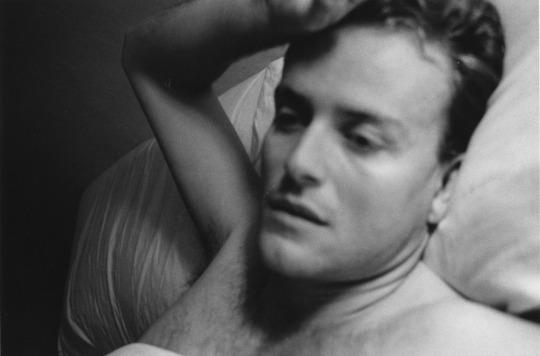
1955 – Hervé Guibert (d.1991) was a French writer and photographer. The author of numerous novels and autobiographical studies, he played a considerable role in changing French public attitudes to AIDS. He was a close friend and lover of Michel Foucault.
Guibert was born in Saint-Cloud, Hauts-de-Seine, to a middle-class family and spent his early years in Paris, moving to La Rochelle from 1970 to 1973. In his teens Hervé Guibert lied about his age to work at the magazine 20 ans eventually leading to a job with Le Monde. After working as a filmmaker and actor, he turned to photography and journalism. In 1978, he successfully applied for a job at France's prestigious evening paper Le Monde and published his second book, Les aventures singulières (published by Éditions de minuit). In 1984, Guibert shared a César Award for best screenplay with Patrice Chéreau for L'homme blessé. Guibert had met Chéreau in the 1970s during his theatrical years.
Guibert's writing style was inspired by the French writer Jean Genet. Three of his lovers occupied an important place in his life and work: Thierry Jouno, director of an institute for the blind whom he met in 1976, and which led to his novel Des aveugles; Michel Foucault, whom he met in 1977; and Vincent Marmousez, a teenager of fifteen who inspired his novel Fou de Vincent.
In January 1988 Guibert was diagnosed with AIDS. From then on, he worked at recording what was left of his life. In June the following year, he married Christine, the partner of the late Thierry Jouno, so that his royalty income would eventually pass to her and her two children. In 1990, Guibert publicly revealed his HIV status in his roman à clef "À l'ami qui ne m'a pas sauvé la vie" (published in English as To the Friend Who Did Not Save My Life). Guibert immediately found himself the focus of media attention, featured in newspapers and appearing on several television talk shows.
Two more books also detailing the progress of his illness followed: Le Protocole compassionnel (published in English as The Compassionate Protocol) and L'Homme au chapeau rouge (published in English as The Man In The Red Hat), which was released posthumously in January 1992, the same month French television screened La Pudeur ou l'impudeur, a home-made film by Guibert of his last year as he lost his battle against AIDS. Almost blind as a result of disease, he attempted to end his life just before his 36th birthday, and died two weeks later.

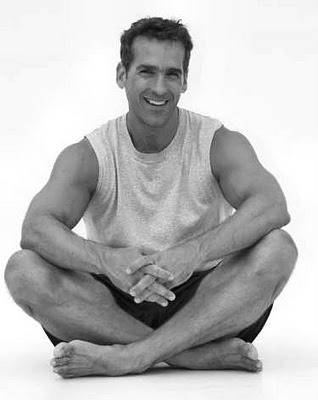
1960 – Bob Paris, American bodybuilder and Gay rights advocate, born; The former Mr. Universe, and International Federation of BodyBuilders professional bodybuilder, Bob Paris is a writer, public speaker and civil rights activist. He acknowledged his sexuality in the July 1989 issue of Ironman magazine and has graced the covers of scores of magazines worldwide. After Paris officially came out as a Gay man in the media, he and his then-partner, Rod Jackson, became involved in marriage equality advocacy, started successful non-profits, lectured on a wide variety of Gay civil rights issues, and made many television, radio, newspaper and magazine appearances. The two separated in 1995. Today, Paris lives with his spouse of eleven years, Brian, on an island near Vancouver, British Columbia. Bob and Brian were legally married after Canada equalized the marriage laws in 2003.
In addition to his writing career, Bob Paris remains a committed civil rights advocate as well as a motivational speaker, model and actor. In 1998, he made his New York stage debut, starring at Carnegie Hall opposite Bea Arthur, Sandy Duncan and Tyne Daly in the Broadway musical, Jubilee as the character Mowgli. He is one of the subject of photographer Herb Ritts' gorgeous book, Duo. His official website is: http://www.bobparis.com/


1968 – Yotam Ottolenghi is an Israeli-English chef, restaurateur, and food writer. He is the co-owner of six delis and restaurants in London, as well as the author of several bestselling cookbooks, including Ottolenghi (2008), Plenty (2010), Jerusalem (2012) and Ottolenghi Simple (2018).
Ottolenghi was conscripted into the Israeli Defense Forces in 1989, serving three years in IDF intelligence headquarters. He then studied at the Adi Lautman Interdisciplinary Program for Outstanding Students of Tel Aviv University, where in 1997, he completed a combined bachelor's and master's degree in comparative literature; his thesis being on the philosophy of the photographic image. While working on his thesis, Ottolenghi served as a night copy editor for Haaretz.
In 1997, Ottolenghi and his then-partner Noam Bar moved to Amsterdam, where he edited the Hebrew section of the Dutch-Jewish weekly NIW and considered getting his doctorate in comparative literature. Instead, he moved to London to study French cooking at Le Cordon Bleu.
Ottolenghi met his partner Karl Allen in 2000; they married in 2012 and live in Camden with their two sons, Max and Flynn. In 2013, Ottolenghi "came out as a gay father" in a Guardian essay that detailed the lengthy process of conceiving Max via gestational surrogacy, an option that he believes should be more widely available to those who cannot conceive naturally.
Ottolenghi served as a pastry chef at three London restaurants: the Michelin-starred Capital Restaurant, Kensington Place, and Launceston Place in Kensington New Town. In 1999, he became head pastry chef at the artisanal pastry shop Baker and Spice, where he met the Palestinian chef Sami Tamimi, who grew up in Jerusalem's Old City. Ottolenghi and Tamimi bonded over a shared language—Hebrew—and a joint "incomprehension of traditional English food".
His debut cookbook Ottolenghi was published in 2008 and has sold over 100,000 copies. Six volumes have followed: the all-vegetable cookbooks Plenty (2010) and Plenty More (2014); Jerusalem (2012); Nopi (2015); the dessert cookbook Sweet (2017); and Ottolenghi Simple (2018).
Ottolenghi's bestselling cookbooks have proven influential, with The New York Times noting that they are "widely knocked-off for their plain-spoken instructions, puffy covers, and photographs [that Ottolenghi] oversees himself, eschewing a food stylist". In 2014, the London Evening Standard remarked that Ottolenghi had "radically rewritten the way Londoners cook and eat", and Bon Appetit wrote that he had "made the world love vegetables".


1989 – Amini Fonua is a Tongan competitive swimmer.
Fonua was born and raised in Ponsonby, Auckland, New Zealand to Tongan lawyer Sione Fonua and British-born mother Julie. He holds dual Tongan and New Zealand citizenship. His family includes two other sisters.
Fonua's swimming career began at the Roskill Swimming Club based at Cameron Pool in Auckland, coached by Sandra Burrow from 1999–2007. He broke numerous Auckland and New Zealand Age Group Records under Burrow's tenure. He then moved to West Auckland Aquatics in 2007, and was coached by Donna Bouzaid. In the Fall of 2008, Fonua enrolled at Texas A&M on a swimming scholarship. While at Texas A&M he was a peer voted Team Captain, Big XII Conference Champion, NCAA All-American, and recipient of The Aggie Heart Award. He graduated with a Telecommunication and Multi-Media degree, with a Minor in Creative Writing in May 2013.
He was the first Tongan swimmer to win a gold medal in international competition, when he took gold in the 50 metre breaststroke at the 2010 Oceania Swimming Championships.
In preparation for the 2012 London Olympics Fonua was trained by New Zealander and designated head coach for Tonga, Jon Winter. He served as his nation's flag-bearer in the 2012 Summer Olympics Parade of Nations. As a swimmer at the 2012 Summer Olympics, he competed in the Men's 100 metre breaststroke, failing to reach the semifinals.
Fonua made an international comeback at the 2015 Pacific Games in Port Moresby, Papua New Guinea. He created history by becoming the first ever Tongan athlete to ever win 3 Gold medals at a Pacific Games by sweeping the Breaststroke events, setting 2 Games Records in the process (50 m and 100 m Breaststroke). He is the only Tongan athlete in history to ever hold dual Oceania and Pacific Games titles.
Fonua is openly gay and an advocate for LGBT rights.


13 notes
·
View notes
Text
The previous part of this series, Part 2, is available here.
In the world of internal Democratic Party politics, the chosen party of the professional-managerial class, fighting for a role in the party hierarchy is done by resume-padding. You have to have worked the correct jobs under the right managers with subsequent letters of recommendation from your patrons, showing both that you care but your primary commitment is to the job itself, not to the cause you were purportedly fighting for in that position. In that sense, Allard Lowenstein fits the bill as a typical upwardly mobile member of the party in the same way Pete Buttigieg does today. If America knows Lowenstein at all, it's from his role in the popular PBS documentary series on the civil rights movement Eyes on the Prize, especially episode 5. The emotional climax of the episode comes over the party machinations to keep the alternative slate of black voters from being seated at the 1964 Democratic convention, which LBJ, Hubert Humphrey, and his protege Walter Mondale succeeded in because of their superior knowledge of debate club tactics. A series of copyright claims by rightsholders for whom licenses had expired kept this show off the air in the 90s, but early filesharing advocates got to work promoting the show across the internet. After all, if they were trying to ban it, it must be important. The clip here is from that episode.
Lowenstein got his law degree at Yale, did his stint in the military like an honorable American, and then got a job from Eleanor Roosevelt directly, always the most powerful player in the party from her husband's death to 1960. However, Lowenstein also cared to an extent. He wanted the black people of the American south to have a chance to vote, based to a large extent on what he witnessed on a fact-finding tour of Namibia, then an internal colony of Apartheid South Africa. His passion was such that he was a major player in the movement to prevent LBJ from being renominated in 1968, recruiting Eugene McCarthy to run against him. This was because they were both politics nerds in the West Wing sense. Young guns, they believed they knew better than the Democratic machine politicians what voters wanted. They knew the people wanted an anti-war candidate who satisfied liberal pieties and who thumbed his nose at the old hierarchies. The result was three unsuccessful campaigns for presidential nomination and Lowenstein himself becoming a one-term congressman. As Gus Tyler, president of the International Ladies' Garment Workers Union (himself a young rebel against an old guard at one point, now an old man leading younger women) said, Lowenstein was leading politics "away from economics to ethics and aesthetics, to morality and culture", and ultimately "to the Republican Wolves".
The problem here wasn't that Lowenstein cared too much, as most of his contemporaries wrote. Rather, he'd performed like a racer trying to slipstream/draft who had spun out of control. This was because of Lowenstein's background and training. As the consummate liberal striver, he'd managed to become president of the National Student Association in 1951 (note this in particular for future posts). This was a union of students' unions, which was basically the debate club to end all debate clubs because that's all student unions are. Even today, but especially so in the 40s and 50s, the only reason to get involved in student politics was because it was a training ground for how parliaments and congresses work. All they do is argue over arcane resolutions on mundane subject matter, until one manages to land a blow strong enough to gain a majority in favour. It's a weirdo politics junkie's dream.
Lowenstein brought that energy to organizing black people in the American South. Even before his role in organizing 1964's Freedom Summer in Mississippi, the project for which Chaney, Goodman, and Schwerner were murdered, he was already getting on the nerves of more radical black people. James Forman, right of MLK in the pic below, ended up on the wrong side of Lowenstein at the 1956 NSA convention. Lowenstein didn't want passage of a more progressive civil rights platform than the one the Democratic Party had adopted. At one point, he literally shoved a black man to the microphone to speak on his behalf, according to Forman. He won, of course, because he knew his debate club tactics better.
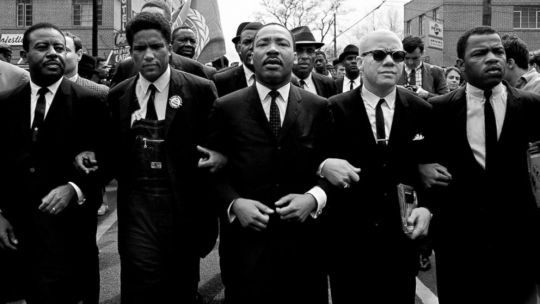
7 years later, Lowenstein and Forman butted heads over the Student Nonviolent Coordinating Committee's work in Mississippi and Alabama. Forman notes that he arrived almost unannounced, and yet many of the white volunteers suddenly claimed that they were under his orders to do what they were doing, including going to towns that were centres of white violence and had no organizing done. As a Yale alumni, Lowenstein probably had links to major white supremacist orgs to protect these people given that Yale was the university of choice for white southerners in the Ivy Leagues. On the other hand, Lowenstein's line was against black radical politics and towards conciliation. Forman found that Lowenstein often worked hand-in-hand with Bayard Rustin, James Farmer, and John Lewis (far right in the pic above), and were close to Norman Thomas and Michael Harrington's Socialist Party (eventually Democratic Socialists of America), bankrolled by Walter Reuther of the United Automobile Workers union. He was particularly piqued when they went to the Dominican Republic as supposedly independent observers and certified the election of the pro-American candidate not long after an American invasion, despite the well-known popularity of his opponent Juan Bosch.
This rankled Forman because the struggle in America for the civil rights of black people was part and parcel of the decolonization struggle abroad, or so he thought. To have America going around and imposing governments on nations through its military industrial complex and arcane intelligence apparatus reeked of what South Africa was doing in Namibia. After all, there was a reason the SNCC had adopted the phrase "one man, one vote" for its 1964 Freedom Summer campaign: it had been a slogan of the 1958 All African Peoples' Conference, the first meeting of black revolutionaries from all of Africa in history.
This conference was convened by the newly independent Ghana, the eighth independent nation in Africa and the first of a long wave which gained independence between 1958 and 1994. The resounding waves of this action were felt in America. Martin Luther King Jr explained in an interview that year "This event will give impetus to oppressed peoples all over the world. I think it will have worldwide implications and repercussions—not only for Asia and Africa, but also for America… At bottom, both segregation in America and colonialism in Africa are based on the same thing—white supremacy and contempt for life". But "Our independence is meaningless unless it is linked up with the total liberation of the African continent", incoming Ghanian prime minister Kwame Nkrumah declared, which is why the All African Peoples' Conference had to be held.
Nkrumah did not learn his debating skills from the NSA. As a student in America in the 30s, he'd given sermons in churches across New York City and Philadelphia, talking always about Africa. Yet it was his experience of American segregation that radicalized him. Being told he was only fit to drink from a spittoon was one of many insults he faced from white Americans. At times, he would buy a subway ticket so that he had a place to sleep. He knew the civil rights struggle was the same as his own, and this followed to the rest of his government. When Ghana became independent, it had virtually no skilled workers because universities in the country barred black students and everybody who had the ability travelled to America to learn. In 1958, Nkrumah spoke at an NAACP dinner in Harlem, telling black American dignitaries that the next step in their fight for civil rights was to send their well educated members back to Ghana, where they would receive a warm welcome and teach their fellow Africans to build a strong, independent nation that could one day bring together a united Africa to rival America.
The opening salvo in this project was the call for all freedom fighters of Africa to send representatives to the AAPC. Nkrumah welcomed them personally. First came Tom Mboya (keep your eyes on this guy) from Kenya, a trade unionist official and future Minister of Justice who one day soon would ensure a member of his tribe, Barack Obama Senior, made his way to America to attend university. Future successful and failed revolutionaries like Joshua Nkomo, George Padmore, Kenneth Kaunda, Hastings Banda, Frantz Fanon, Dr. Felix-Roland Moumie, and Holden Roberto, as well as notable black US Congressman Charles Diggs, were among 300 delegates. Perhaps the most important delegate was accidental. Joseph Kasavubu had initially been invited as the representative from the Congo. However, when the plane to Ghana stopped in Leopoldville/Kinshasa, Belgian authorities had stopped him from getting on, recognizing him from anti-colonial speeches earlier. However, they did allow Patrice Lumumba and two comrades who had impressed the plane's passengers with their rhetoric at a bar to join in. When Nkrumah met Lumumba, he was deeply impressed and called for a photographer to record the moment.
Also among them was Horace Mann Bond as a representative of the African American Institute, a group funded by western mining interests but staffed with academics from major American black universities like Howard and Lincoln. He brought along a reporter named Bob Keith, who was arrested during a closed session of the congress with bugging equipment. Bond was also president of the American Society of African Culture. AMSAC had deep pursestrings, bailing out a number of black groups soon after it was founded, and sponsored Bond as well as CUNY professor John Aubrey Davis, who reported on all the proceedings to former National Student Association president and current AMSAC leader James Theodore Harris Jr, according to AMSAC's archives. A third group that attended the conference was the Congress for Cultural Freedom, who sent white AFL-CIO leader Irving Brown. AFL-CIO in turn sponsored International Ladies' Garment Workers Union member Maida Springer, one of the few black women. One thing that AAI, AMSAC, AFL-CIO, and CCF shared was an explicit commitment to anticommunism in their charters, even as some claimed apoliticality otherwise. CCF sent its future president, South African poet Ezekiel Mphaphele. Some CCF funding came from the Fairfield Foundation, a charitable organization that sent its own observer Patrick Duncan, a white member of the South African Liberal Party. Other funding came from the Ford Foundation, which sent white University of California Santa Cruz professor John A. Marcum on its own. Marcum and Brown helpfully offered to translate ad hoc between French (spoken by Lumumba) and English (spoken by Nkrumah), and the two report an unknown American helping them with all their conversations.
I note these people because they or the organizations that sponsored them were all revealed to be CIA fronts or conduits by the magazine Ramparts in 1967 (Brown's one time boss at the CIA's International Organizations Division, Thomas Braden, wrote a response entitled "I'm glad the CIA is 'immoral'"). Many of them defended themselves by saying they were unaware of where the money was coming from or that they did not know the people they reported to were compromised. As Ramparts was drawing primarily on IRS information that had been leaked as well as corroborating testimony, they did not know the full extent of their integration into the intelligence apparatus. As many of these organizations folded in the 70s and 80s after these revelations their archives were given over to universities for preservation. They were rarely perused, two notable exceptions being by Frances Stonor Saunders and Hugh Wilford in the 90s and 2000s respectively. What they revealed was not wholesale domination or complete innocence, but rather a joy that the CIA was funding them to do what they knew was the right thing combined with strident insistence to the conduits for their funding that they not be forced to do anything that would contradict with their politics. When Farmer, of Forman's Lowenstein faction at CORE and SNCC, went on an AMSAC-sponsored tour of Africa, he criticized Malcolm X's beliefs as "apartheid and… worse", then got into arguments with diplomatic staff for his criticisms of American policies towards South Africa, Portugese Africa, and most of all the Congo. He later claimed that seeing apartheid abroad helped to calcify his opinion the American government. When Brown became harshly critical of Nkrumah, Springer, his subordinate and mentee at AFL-CIO, explained decades later that the 1958 conference gave her "goosebumps" and was more significant than the fall of the Berlin Wall in her opinion.
Evidently, many of these liberals, like the more radical leftists they battled, viewed the American civil rights struggle as an anti-colonial one. So too did the CIA, given the similar manner in which they infiltrated both through the liberals. However, portrayals of the struggle in popular culture like Eyes on the Prize show nothing of the sort. They tend to show a struggle from the streets right into the Democratic Party. This pattern also befits all of the above named associated with the CIA, albeit with the ones less inclined to support whoever the current president was also ending up becoming less powerful. Typically, they emerged in academia rather than politics, ie the other glorified debate club. In contrast, the radicals tended to find themselves sidelined or shot. Forman was an early supporter of the Black Panthers along with his associate at the SNCC Stokely Carmichael, but as the group descended into factional infighting, his former comrade stuffed a pistol in his mouth and threatened to shoot, giving him a nervous breakdown. He went into academia and helped ensure his son, now a Yale Law professor, could do the same. To co-author his autobiography, "The Making of Black Revolutionaries", Forman picked Julian Bond, son of Horace Mann Bond.
‘Irving Brown was never a CIA agent’, said Cord Meyer, the head of the International Organizations Division of the CIA. ‘The very notion is laughable. He was as independent as you could get, and very strong-willed. What the CIA did was to help him finance his major projects when they were crucial to the Western cause. But in his operations he was totally on his own’.
35 notes
·
View notes
Text
Ranting and Raving: "Come Dancing" by The Kinks
youtube
When looking at the British Invasion of the sixties, there is something known today as “The Big Four.” That group refers to the four bands that led the musical invasion on American shores: The Beatles, The Rolling Stones, The Who, and finally, The Kinks. The Kinks were entered into that club way later than the other three. It took more time for people to realize that the band were of the same caliber and helped pave the way for a lot of music we hold dear today just the same as the others.
But the Kinks ended up having a wildly different career trajectory than those other three. Mostly because they were banned from playing in America from 1965-1969.
The exact reasons for why tend to boil down to this: When attempting to tour America in 1965, there was tension between primary songwriter/guitarist/vocalist Ray Davies and his brother, guitarist Dave Davies (who also had beef with at-the-time drummer Mick Avory, sometimes losing it and fist-fighting him on stage), they all had beef with their tour promoter, Betty Kaye, who was unable to pay them in cash (which was the agreement that was made and unable to be fulfilled due to poor ticket sales at the beginning of the tour) and when that happened, the band was pissed and decided to retaliate against her. This in turn led her to filing a formal complaint with the American Federation of Musicians (basically the organization who has the power to withhold work permits for overseas musicians in the event that, you know, they piss you off and are difficult to deal with). That complaint held weight and the band were, well, banned from playing in the states. By the time the ban was lifted in ‘69, the British Invasion was over and done with and the tastes had changed.
In a way, I think this actually ended up being a blessing in disguise for them. The other three bands they’re grouped with all ended up getting Americanized in some way due to spending extended time here and trying to appeal to us. By contrast, The Kinks were stranded and remained aggressively British, so they stayed weird and their music remains all the more fascinating to Americans because it wasn’t made with any of our sensibilities in mind. The only times the band snuck over here and scored a Top 40 hit twice during the seventies. “Lola” was the big one in 1970 (peaked at #9 on Billboard) and “Rock and Roll Fantasy” was the other one in 1978 (peaked at #30). So as far as America is concerned, the seventies weren’t the best decade for the band in terms of chart success. They would go mostly ignored.
The Beatles, The Stones, and The Who all had a great time here in the seventies... but the eighties belonged to the Kinks, who had a way more fun time during that decade than any of them. By the start of the eighties, the Beatles had been broken up for a decade (one of them would be dead by the end of 1980, one of them sits out most of the first half of the decade, one of them doesn’t know what the hell they’re doing, and one of them is Ringo) the Stones were about to go on autopilot and enter suck for a decade, and the Who were quickly suffering burn out. On the other hand, The Kinks had been enjoying critical and commercial success and enjoyed experimenting with the new wave and punk sound that had been sprouting up in Britain. It certainly helped that a lot of new wave and punk bands loved them and were covering their songs. Listening to albums like 1981’s Give the People What They Want and 1983’s State of Confusion are good examples of Ray Davies’ versatility and adaptability as a songwriter. He just seemed to understand the changing times better than the rest of the old British Invasion bands. I mean, bloody hell, you don’t call an album Give the People What They Want unless you’re damn sure you know what they want. The Kinks have five songs that have been Top 10 hits on Billboard: “You Really Got Me” (#7 in 1964) “All Day and All of the Night” (also #7 in ‘64), “Tired of Waiting For You” (#6 in 1965), “Lola,” and finally, their last and quite possibly the best song Ray Davies wrote in his long career, “Come Dancing” (#6), released in April 1983 (for America, Britain had it in October ‘82) and our subject today.
“Come Dancing” is one of those hits that defies most explanations. By all accounts, Americans at the time should’ve wanted nothing to do with it and it never should’ve been a hit here. By the time the song hit its peak in July 1983, It didn’t fit in with anything else that was on the Top 10. That is, unless there’s a part of your brain that thinks the Kinks can share a playlist with the likes of The Police, Irene Cara’s “Flashdance... What a Feeling” (from, you guessed it, the movie Flashdance), Michael Jackson, Culture Club, and Kajagoogoo, which sounds like a name I made up, but I swear to god I didn’t. Adding to the anomaly is how Ray Davies didn’t write this with an American audience in mind at all. For starters, he makes no attempt to hide his accent (although Ray is so aggressively British you’d have to be the most daft and schtewpit wanker alive not to notice). Other giveaways are how the song talks about dance halls (which is primarily a British concept. He also uses the French word “Palais” to mean “dance hall,” which only further alienates us Yankees) and the song borrows its title from a popular British dancing show, Come Dancing (it’s mostly known today through its revival, Strictly Come Dancing).
“Come Dancing” is mainly concerned with two topics: 1) It’s a song examining the changing times and memorializing the past. The dance hall of Ray’s childhood is long gone and has been replaced with several different things ever since. 2) It’s a story song about his older sister, Rene. More on her later.
If this song became a hit for any reason, it’s because Ray Davies’ ear for melody never failed him. That main melody that plays through the song is ridiculously infectious. It does what every great song wants to do: sneak into your brain and have you hum it for a long time after it’s over. Musically, it’s delightfully strange. The chorus has that British Invasion sixties sound that taps into boomer nostalgia (which would quickly wrap the eighties into a vice grip tighter than a rattlesnake) but it never fully consumes the song. The main melody has that sixties sound when played on a guitar, but it’s almost drowned out by the odd choice in keyboard sound, which sounds like something you’d hear on a calliope or a boardwalk in the summer. While being odd, it’s an immediately recognizable sound that works really well. It’s very easy to start dancing to it and, more importantly, it’s such a great melody that it never gets obnoxious or annoying to hear.
The most interesting thing about it is that it’s a melody that feels like it’s fighting to find a spot in a specific time period. Dave Davies’ guitar makes it sound sixties, the keyboard turns it distinctly into 1983, and then it travels back to the big band era of the forties and fifties when horns play it at the end of the song. It’s a melody that’s clearly nostalgic for something, but it and its creator never find exactly what it’s nostalgic for. There’s an argument to be made that the entire song is nostalgic for everything and that’s why there’s no specific choice. In that sense, the song perfectly captures that feeling of experiencing changing times. What you knew is gone forever and you’re having to come to terms with the new. The overall production, the keyboard doing the main melody, that new wave sound and Dave’s heavy guitar riffs during the halfway point of the song, and the chorus are all firmly in the new. The keyboard during the verses, the acoustic, folksy guitar heard throughout the song, and the big band horns at the end are all the faded voices of the old trying to be new again. Ray Davies is very well aware of time and the way time changes things as major themes within this song. Those themes show up as early as the first lines of the song, when he lays out the history of the local palais in just four lines:
They put a parking lot on a piece of land
Where the supermarket used to stand
Before that they put up a bowling alley
On the site that used to be the local palais
Local palais -> bowling alley -> supermarket -> parking lot. Anybody who has lived in a small town for decades or has lived long enough to see major changes to places can rattle off history like that to you. Even if you haven’t, sometimes you can just walk into a store and you can faintly see the remnants of what used to be there, possibly something to the tune of, “This coffee shop used to be a Pizza Hut.” Ray Davies establishes that theme from a distance immediately so that he can zoom in just as fast and begin to tackle the song’s real reason for being: a story song about his older sister, Rene.
Ray Davies has six sisters, all of them older than him, but it’s Rene who hit the jackpot and got this song written about her. The backstory of “Come Dancing” is this: Ray wrote the song in honor of his sister’s love of dancing and to honor her passing away from a heart attack on the night of Ray’s thirteenth birthday while out dancing at the local palais. She was also the sister that bought Ray’s first guitar for him (you can see the kid in the music video air strumming a tennis racket, which I’ve always assumed was a nod to Ray being given a guitar). In a 2014 radio interview with NPR, Davies recounted the stories that inspired the song:
...she was told she had severe heart problems, but she loved to dance. And the doctors told her, she walked down the road, she would probably have a heart attack. So she bought me this not-very-expensive Spanish guitar and gave it to me on my birthday. And she - we played a few songs. She played a song on the piano. And I tried to play with her. And she said she was going out now. And I would watch my sister go out.
It was a sunny afternoon. And she walked down the road, and my mother stood at the gate. And that was it. And the next morning, we got a call from the police. She'd been - she had died dancing at the ballroom in London in the arms of a stranger. And they came to break the news to my parents. So it was - the birthday was forgotten, but that's irrelevant.
From the last line of the first verse to the end of the song, it becomes a beautiful eulogy about the loss of Ray’s sister and the dance hall that held her happiest memories. The story that Ray tells in that NPR interview is found all throughout the song’s lyrics. Ray mostly focuses on the boyfriends and dates that his sister would go on and even how Ray could see her coming and going (“Out of my window, I could see them in the moonlight / Two silhouettes saying goodnight by the garden gate”). Ray paints a fun, upbeat, and bouncy picture of his sister as your typical fun-loving girl who loves to dance and would make her dates work for (limited) satisfaction.
Another Saturday, another date
She would be ready but she'd always make them wait
In the hallway, in anticipation
He didn't know the night would end up in frustration
He'd end up blowing all his wages for the week
All for a cuddle and a peck on the cheek
The lyrics stay just as light and peppy as the song they’re attached to. Despite the fact that Ray is writing this song about a woman who passed away twenty-five years before this song existed, the only sadness to be found is the death of the palais (The day they knocked down the palais / Part of my childhood died, just died).
The final verse of the song is the most important part. We’ve established that in real life, the person this song is written about passed away twenty-five years prior. In the song, she isn’t. Ray Davies utilizes the power that comes with being a songwriter and fully rewrites her ending. This part is real: “Now I'm grown up and playing in a band / And there's a car park where the palais used to stand.” These lines aren’t:
My sister's married and she lives on an estate
Her daughters go out, now it's her turn to wait
She knows they get away with things she never could
But if I asked her, I wonder if she would
With this final verse, “Come Dancing” becomes a song that resurrects the past and gives it new life. “Come Dancing” isn’t just a nostalgia song, it’s a resurrection song. A nostalgia song usually is too preoccupied with the yearning for days gone by, the dread that comes with knowing that the old days are gone forever and you wish like hell that they were back. “Come Dancing” isn’t that. The final refrain of the chorus has Ray singing, “Come dancing / Just like the palais on a Saturday.” The key words are “just like.” Ray knows that he can’t literally bring the palais back (or his sister, for that matter), but as a songwriter, he can resurrect the feelings and the memories of the palais on a Saturday. He can resurrect the feelings and the memories of his sister and how she would go dancing.
It’s a beautiful and loving tribute to someone dearly departed. If you believe in any variation of the phrase, “The dead are never truly gone so long as the memories remain,” then this song does what a lot of songs do when they make us think of the people closest to us: it resurrects their memory and helps us remember them and how we carry them with us.
It’s the most unexpected hit they could’ve had during the second half of their career and it remains one of their sweetest and most lovable songs. It represents the romanticism, the cleverness, and the theatricality that made the Kinks such a wonderful band and so distinct from their peers.
“Come Dancing” is the best possible tribute. It brought Ray’s sister and the old local palais back to life every time he and the Kinks played it. They come back to life every time you play it on something. If you have someone special to you who loved this song to death, they come back too whenever you play it. Hell, when Ray Davies eventually leaves this Earth, this song will also bring him back to life every time someone plays it.
Time moves, whether we want it to or not. But if we’re lucky, we’re able to capture a few magic moments and make them immortal. Nothing is ever fully dead so long as there’s someone there to fill it with love and resurrect it.
So, why not come dancing?
It's only natural.
8 notes
·
View notes
Text
Today's Black History Month illustration is of Althea Gibson. She became the first Black athlete to cross the color line of international tennis and golf. (She has a TON of records, so here it goes!)
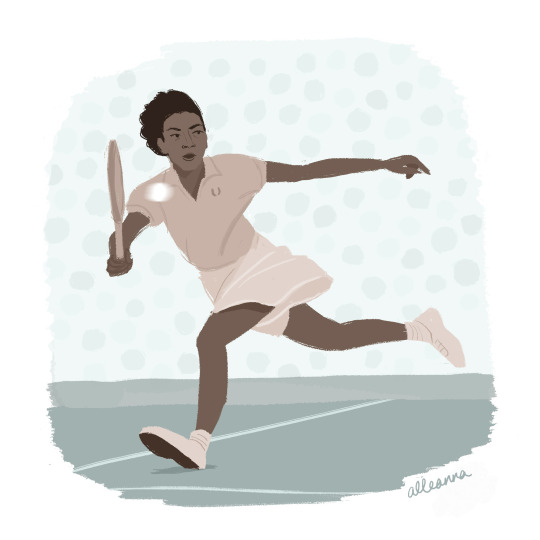
Gibson was born in 1927 on a cotton farm in South Carolina, but her family moved to Harlem in 1930. While growing up in NYC, she played paddle tennis under the supervision of the New York Police Athletic League. She became so good at paddle tennis that by the age of twelve, she won the NYC women’s paddle tennis championship.
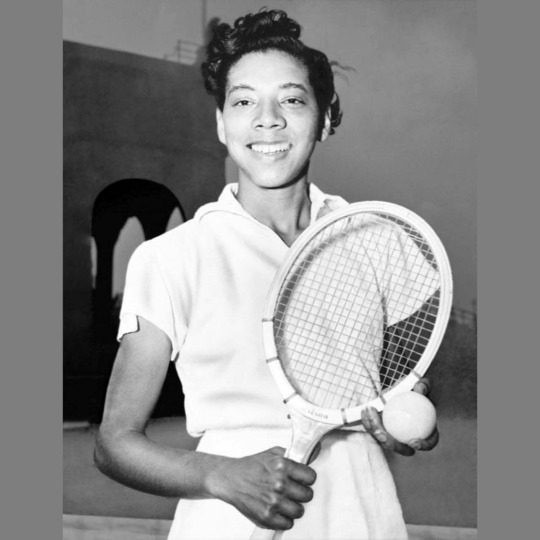
In 1940, a group of Gibson’s neighbors put money together to pay for her junior membership at the Cosmopolitan Tennis Club in Harlem. A year later, she won her first tournament, the American Tennis Association’s NY State Championship, founded by Black tennis players. She won the ATA national championship in 1944 & 1945. In 1947, she won the ATA’s women’s singles championship, which she continued to win for 10 consecutive years.
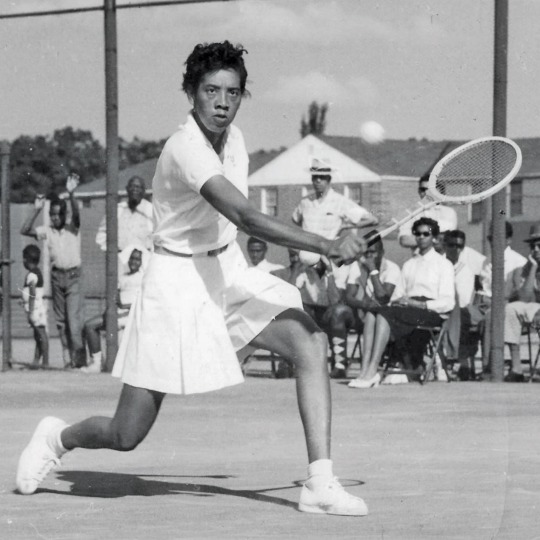
Her success drew the attention of Dr. Walter Johnson, a Black physician from Virginia who was also an avid tennis player. He mentored her and helped her enter into competitions with the US Tennis Association (USTA). In 1949, she became the first Black woman and second Black athlete to play in the USTA’s National Indoor Championship. After that, she received a full athletic scholarship at Florida A&M.

In 1950, Gibson became the first Black to compete in the US Open at Forest Hills in Queens, NY. In 1956, she became the first African American to win the French Open. In 1957, she won Wimbledon, and received the trophy personally from Queen Elizabeth. She won the doubles championship as well and when she returned to NYC, she became the second athlete (after Jesse Owens) to receive a ticker tape parade.
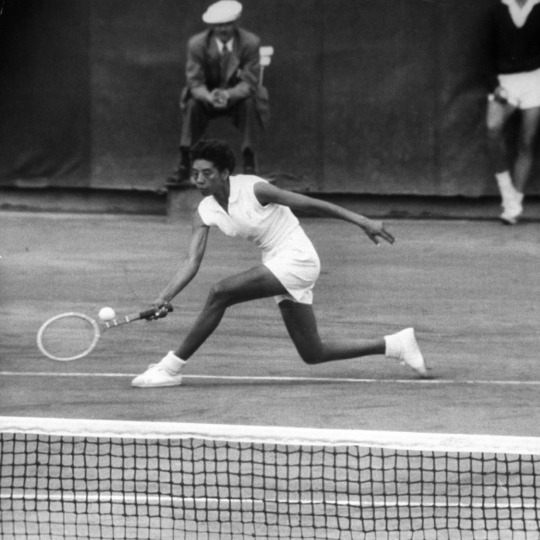
In late 1958, after winning 56 national and international singles and doubles titles including 11 Grand Slam championships, she retired from amateur tennis at the age of 31. In 1964, at the age of 37, she became the first Black woman to join the Ladies Professional Golf Association (LPGA) tour. Her best tournament finish was a tie for second place at the 1970 Buick Open.
Overall, Althea Gibson is considered to be one of the greatest tennis players in history and paved the way for players like Venus and Serena Williams.

I’ll be back tomorrow with another illustration and story!
#Althea Gibson#black history month 2023#black history month#black history 365#artists on tumblr#illustrators on tumblr#black women art#kidlitart
47 notes
·
View notes